Ultimate 10 Day South Africa Itinerary: Cape Town, Kruger & Garden Route
After spending months living in Cape Town and traveling across South Africa, I can honestly say this country is an adventure lover’s dream. South Africa has it all – epic mountains, wild safaris, world-class surf and vibrant cities. If you know how we operate, we didn’t just pass through. We settled in, explored every corner, and soaked up the local culture. That’s why our advice for this 10 day South Africa itinerary comes from real, on-the-ground experience, not just a quick visit. We know the best times to go, how to get around and those hidden gems you won’t find in every guidebook.
This carefully crafted South Africa itinerary balances its absolute highlights: Cape Town, Kruger National Park, and the legendary Garden Route. Think of it as a tasting menu, each course thoughtfully prepared to give you the best possible experience. You’ll wander charming neighborhoods, taste unforgettable local dishes, come face-to-face with the Big Five and soak in views that make your jaw drop.
If you want to travel while working, just like us, check out our blog on how to travel with your 9-to-5 job.

Days 1–4: Exploring Cape Town & Nearby Highlights
Overview of Cape Town
Wedged spectacularly between dramatic mountains and the roaring Atlantic, Cape Town’s the sort of place that sneaks into your heart and makes you wonder how you ever lived without it. We’ve spent plenty of time wandering these streets, each neighborhood offering a totally different slice of South African life – from beach-chic to artsy-hipster, historical charm to urban sophistication. And the food? Seriously, prepare to loosen your belt a notch or two. When we landed in Cape Town, I had no idea how fast I’ll fall in love with this city.
With four days, you’ll get a perfect snapshot of why Cape Town regularly ranks as one of the world’s best cities. We’ll show you exactly where to go, what to see, and, maybe most importantly, where to eat. A 10 day South Africa itinerary is incomplete without visiting Cape Town.
Did you know? We actually include Cape Town in our top dream destinations to visit while working remotely.
Neighborhoods & What to Do
V&A Waterfront
The Victoria & Alfred Waterfront is touristy, sure, but honestly, it’s worth every minute. There was something infectious about the buzz here. Watch seals lazily sunbathing near the harbor, browse vibrant craft markets or explore stylish shops. The Zeitz MOCAA, housed in an old grain silo, might be the coolest modern art museum we’ve ever visited. Think jaw-dropping architecture and bold African art.
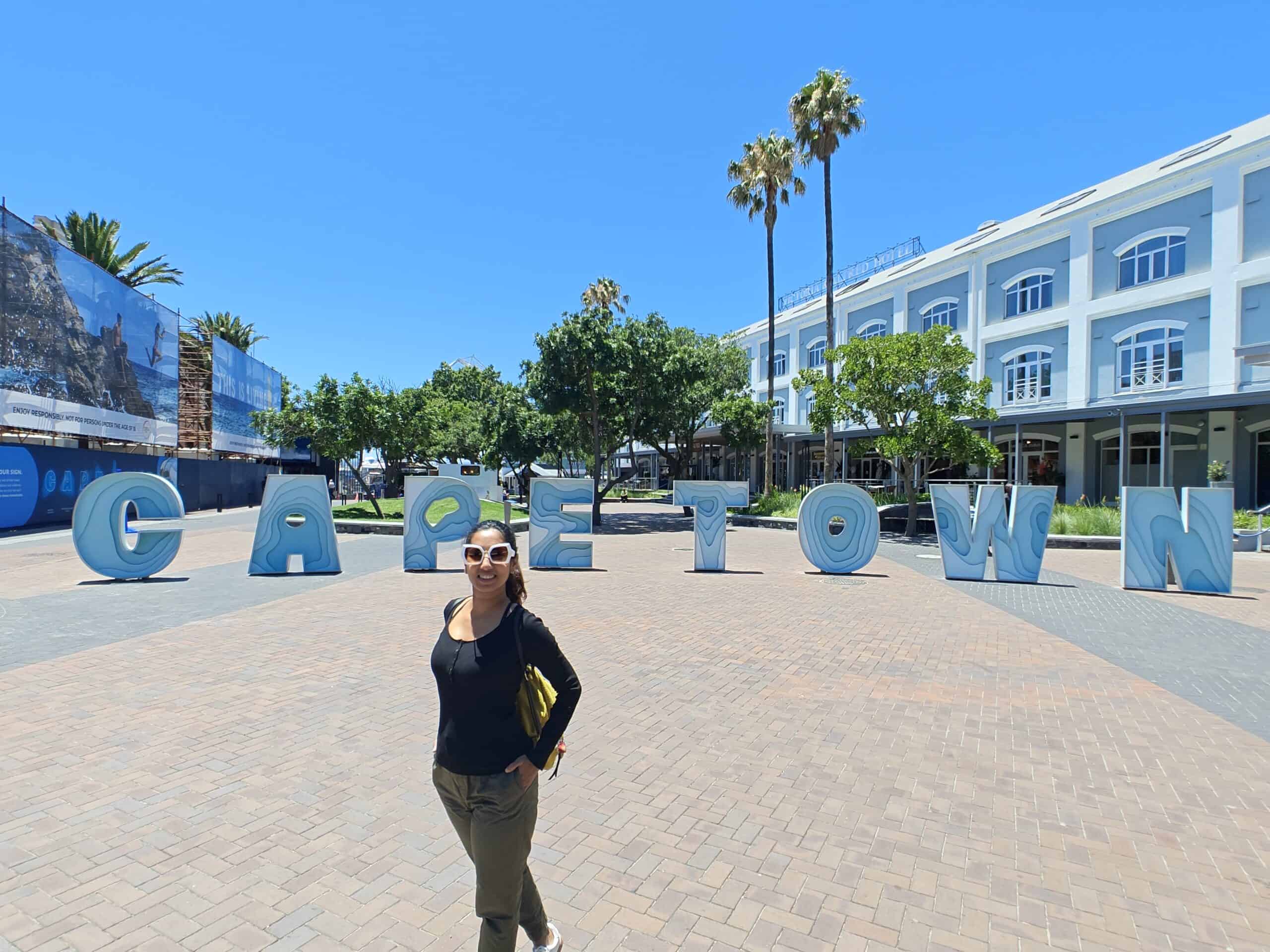
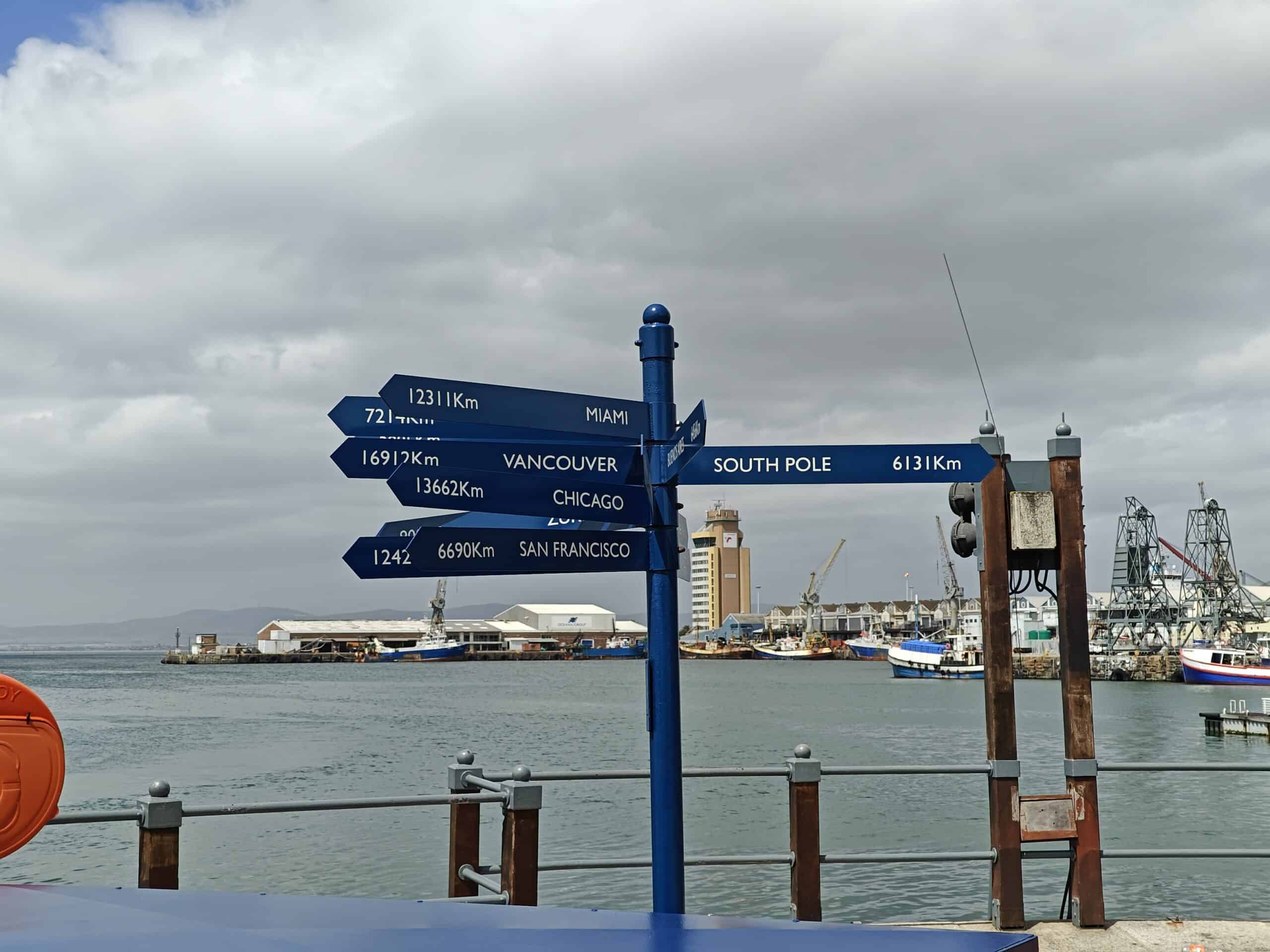
Pro tip: grab a sunset drink at the rooftop of The Silo Hotel; it’s expensive, but the views are legendary.
City Bowl & Bo-Kaap
Picture cobblestone streets winding uphill, lined with vividly colored houses. Welcome to Bo-Kaap. Historically home to the Cape Malay community, this area bursts with culture. Pop into local spice shops, snap photos, or simply chat with locals who we found love sharing stories. Nearby, City Bowl is where you’ll find trendy cafés, eclectic boutiques and the leafy Company’s Garden. It’s perfect for lazy strolls, coffee breaks and people-watching. Don’t miss Truth Coffee on Buitenkant Street. Their steampunk décor and exceptional coffee is a local legend.
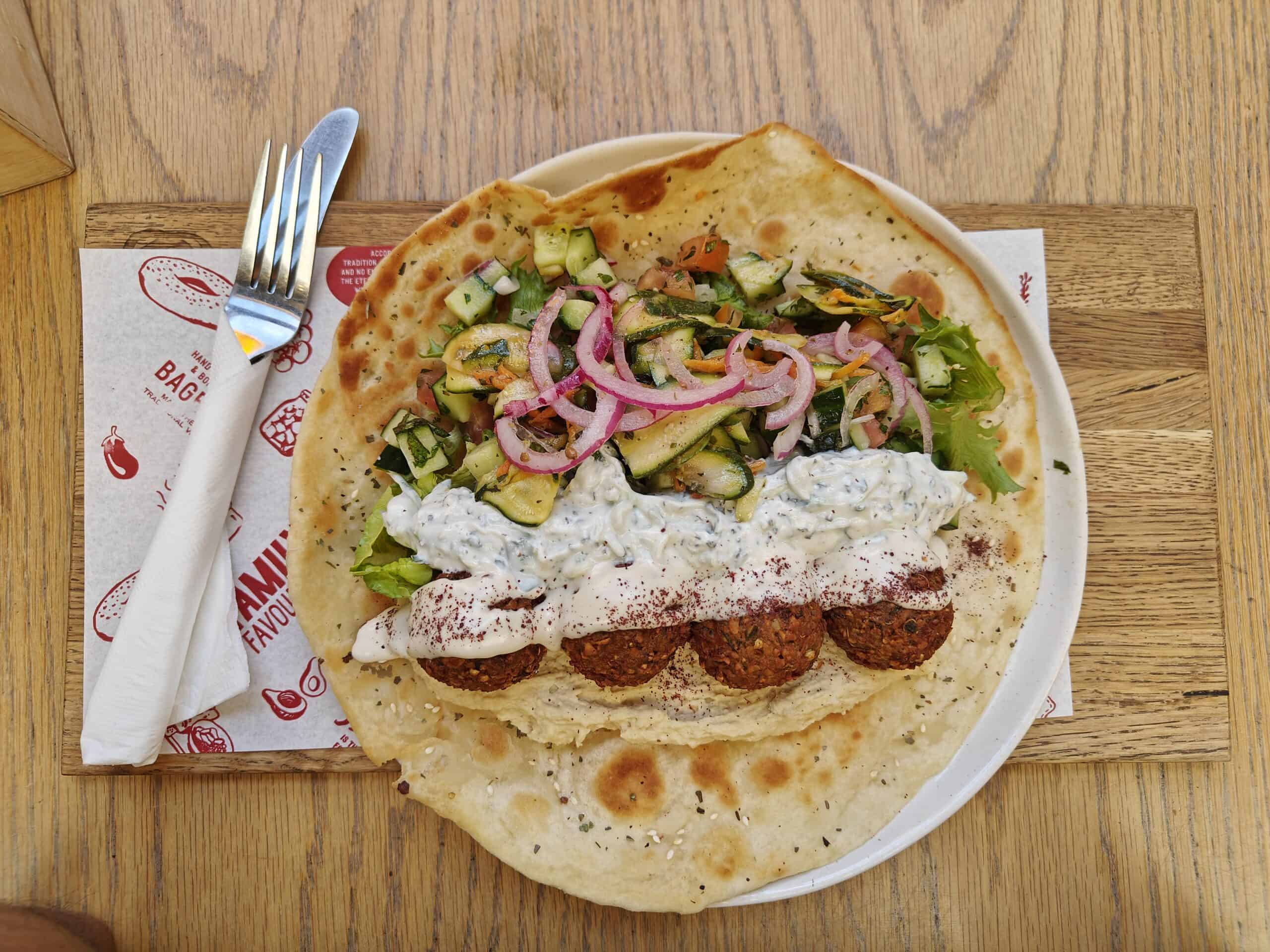
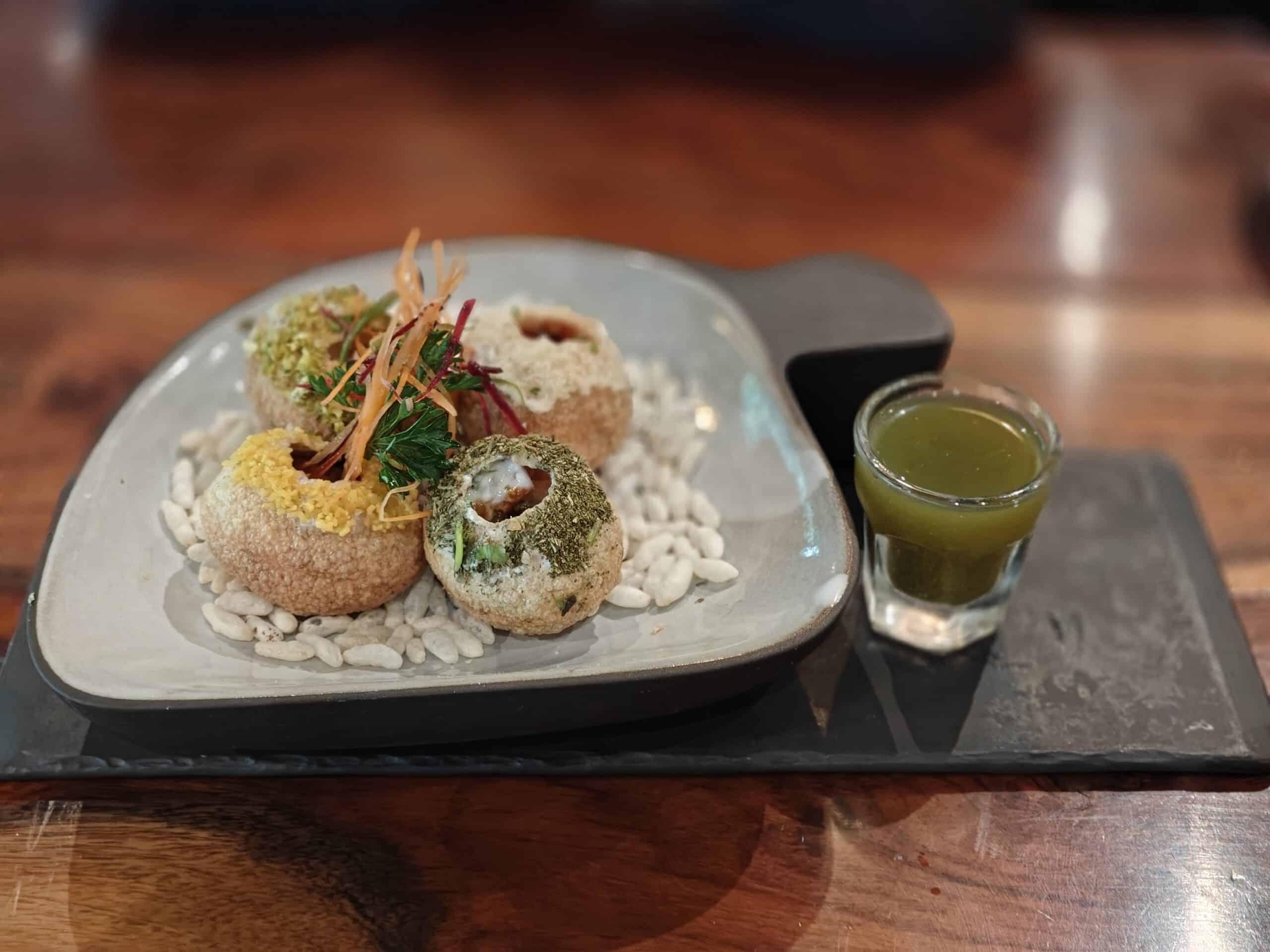
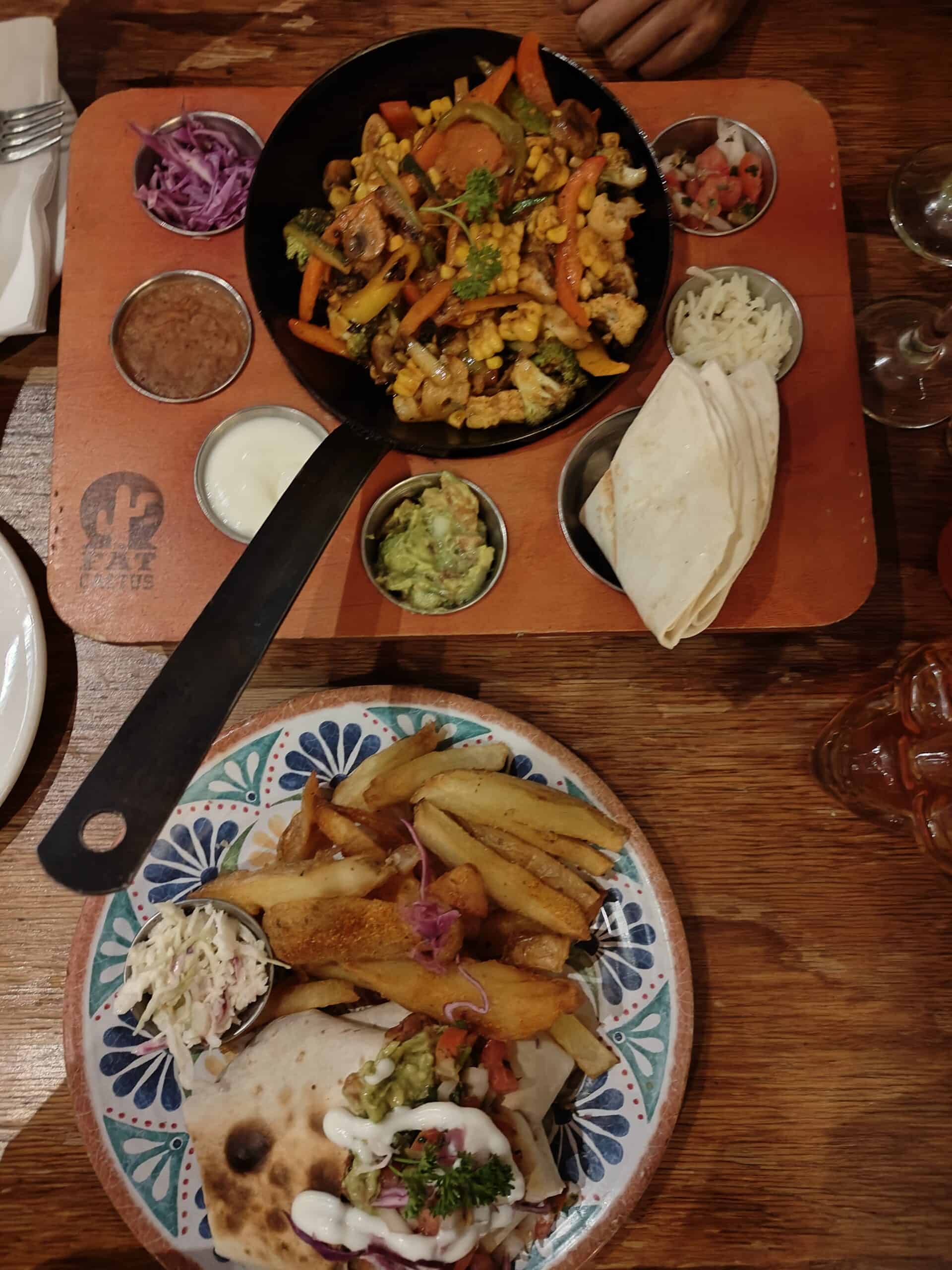
Definitely don’t miss going to Bukhara in CBD or the many brunch places across this area. And take advantage of the very affordable food!
Camps Bay & Clifton
Beach life at its best. Camps Bay feels like Cape Town’s glamorous younger sibling: white sands, palm-lined streets, and cafes serving cocktails with a hefty side of people-watching. We spent many an afternoon with a drink at one of the many promenade restaurants.

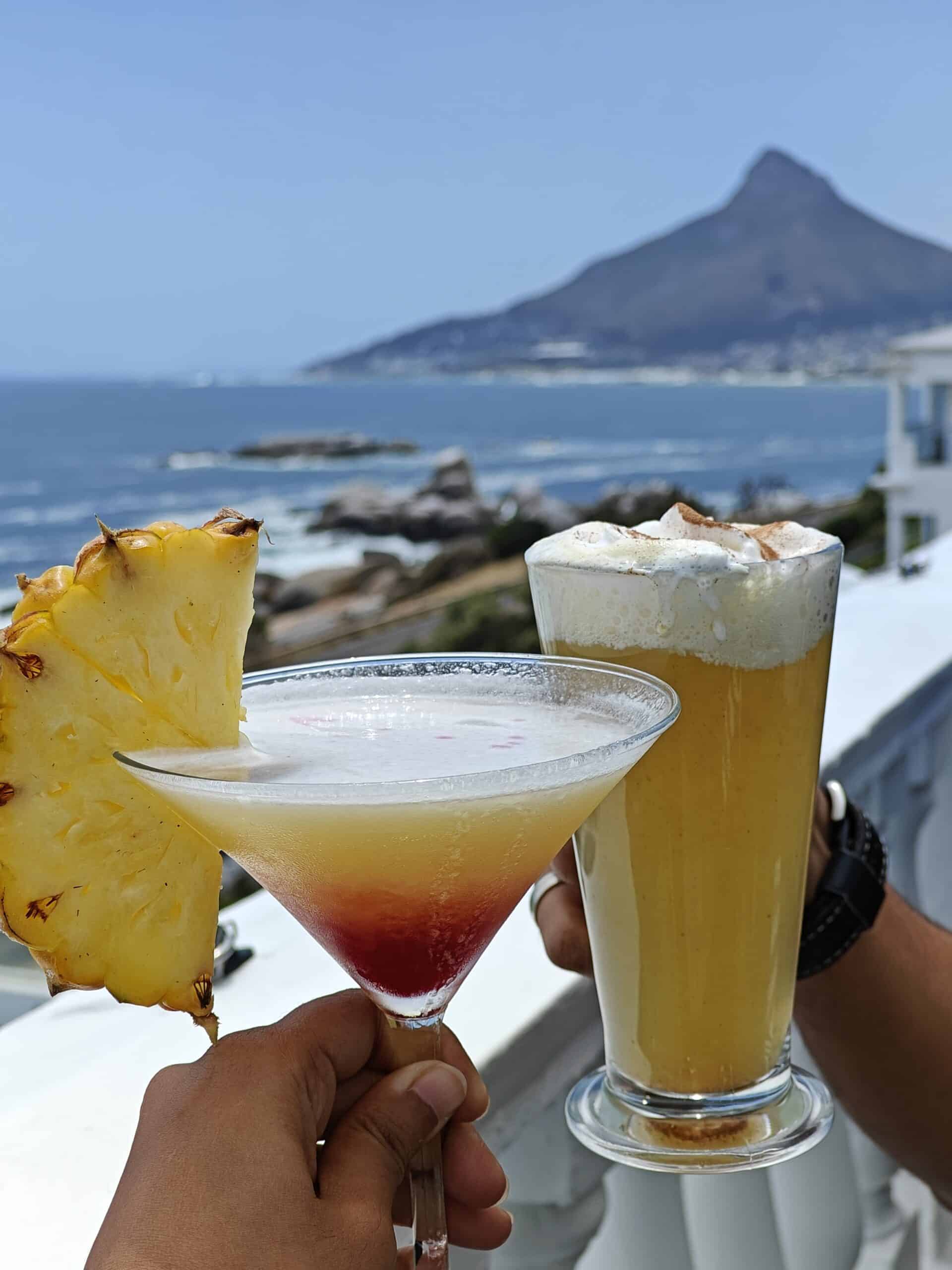
Clifton beaches (there are four!) offer calmer, quieter coves. Pack a picnic or grab ice cream from vendors strolling along the sand. The sunsets are unbeatable, fiery skies melting into ocean waves.
Woodstock
Woodstock, Cape Town’s artistic heartbeat, feels a bit like Brooklyn-meets-Berlin: edgy street art, converted warehouses and hip cafes at every corner. Visit the Old Biscuit Mill, especially on Saturday mornings when it hosts the bustling Neighbourgoods Market. We still dream about the flatbreads and artisanal chocolate we’ve sampled here. Take your time exploring the murals, each tells a unique story, adding color to Cape Town’s evolving identity.
Constantia & Kirstenbosch
Want greenery and tranquility? Head straight to Constantia, one of South Africa’s oldest wine regions. It feels worlds away from the city’s bustle. Being from a wine-growing region ourselves, we absolutely loved the many wine regions near Cape Town, but especially this one.
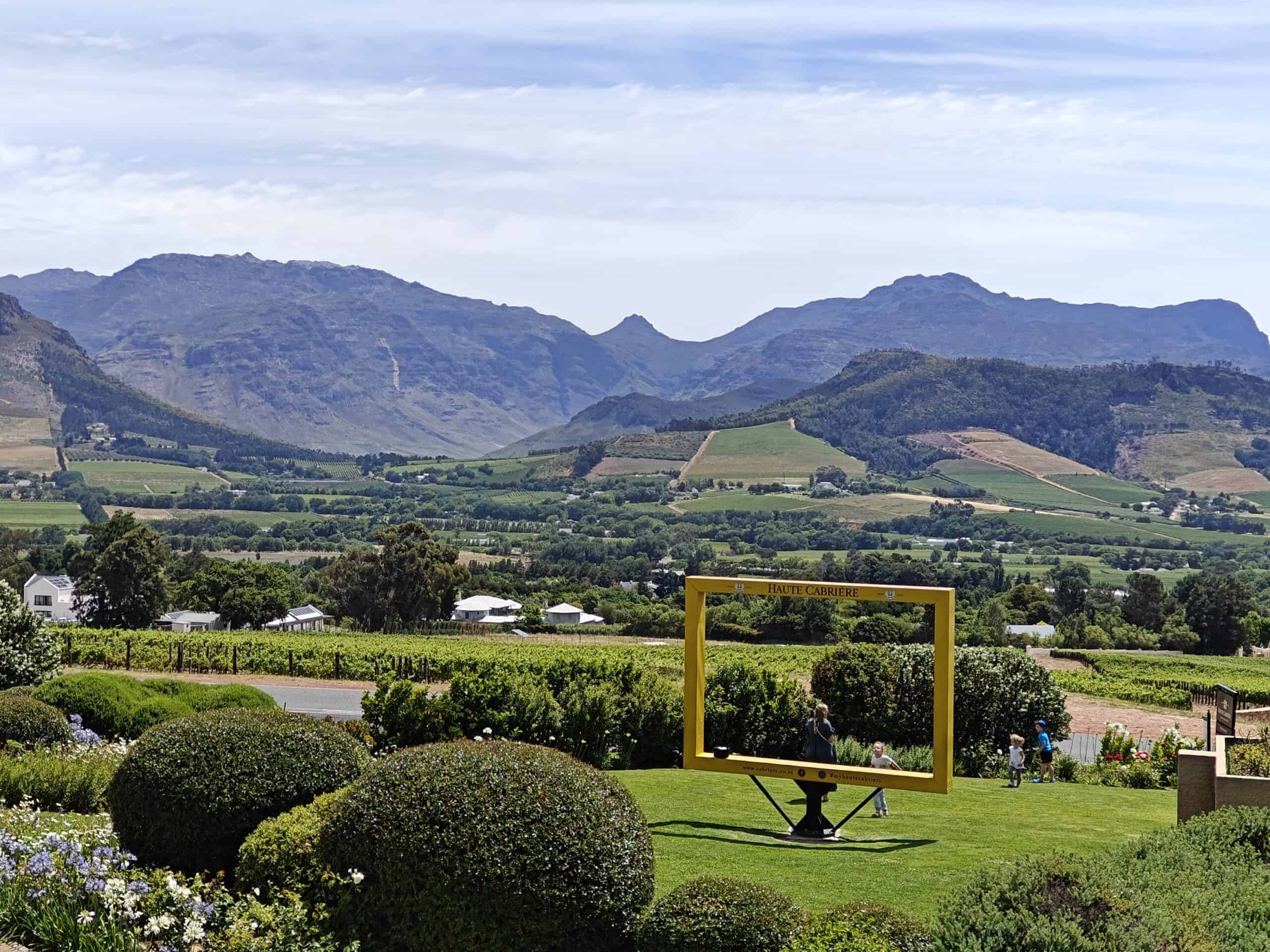
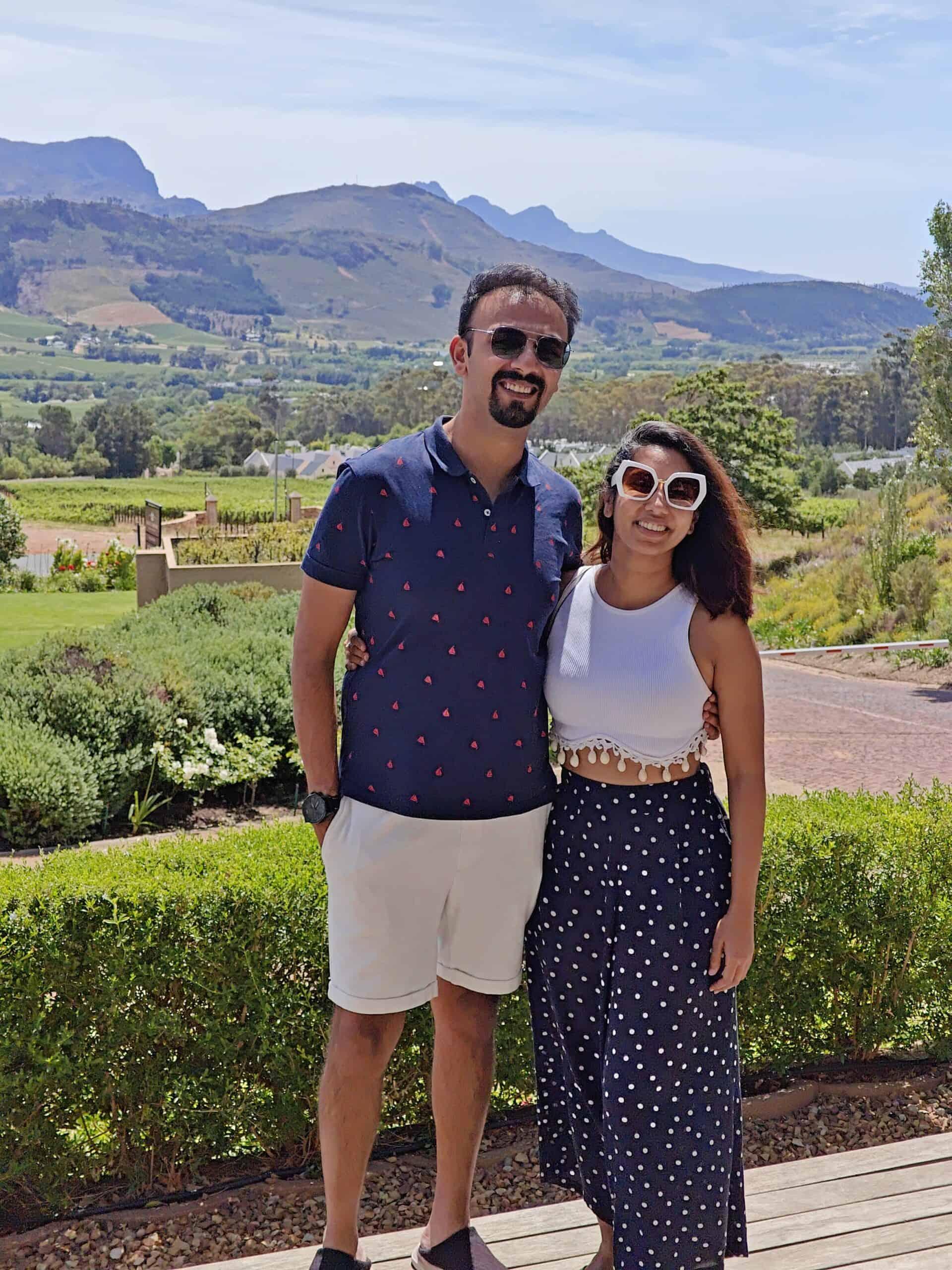
Sample crisp Sauvignon Blancs at Groot Constantia, the area’s oldest winery, or stroll around manicured vineyards. Nearby, Kirstenbosch Botanical Gardens is genuinely magical, packed with indigenous plants, quiet pathways and sweeping mountain vistas. If you time it right, catch a summer concert on the lawns.
Day Trips from Cape Town
Cape Peninsula & Cape Point
This day trip feels like reaching the edge of the world, wild and exhilarating. Rent a car (or join a small tour) and cruise down Chapman’s Peak Drive, one of the most scenic roads in South Africa. While on the return trip, consider visiting Muizenberg for its colorful huts and surfing culture.
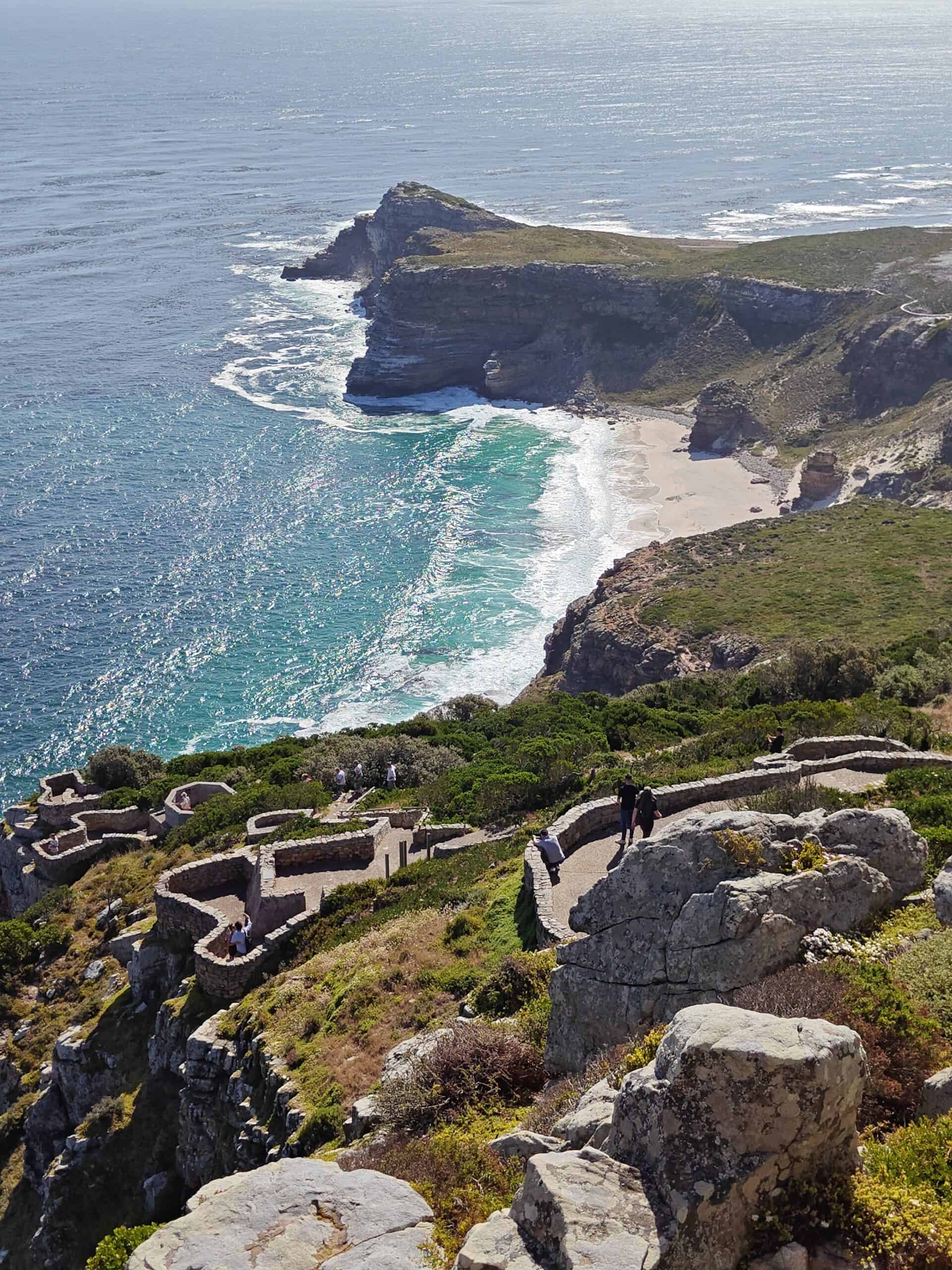
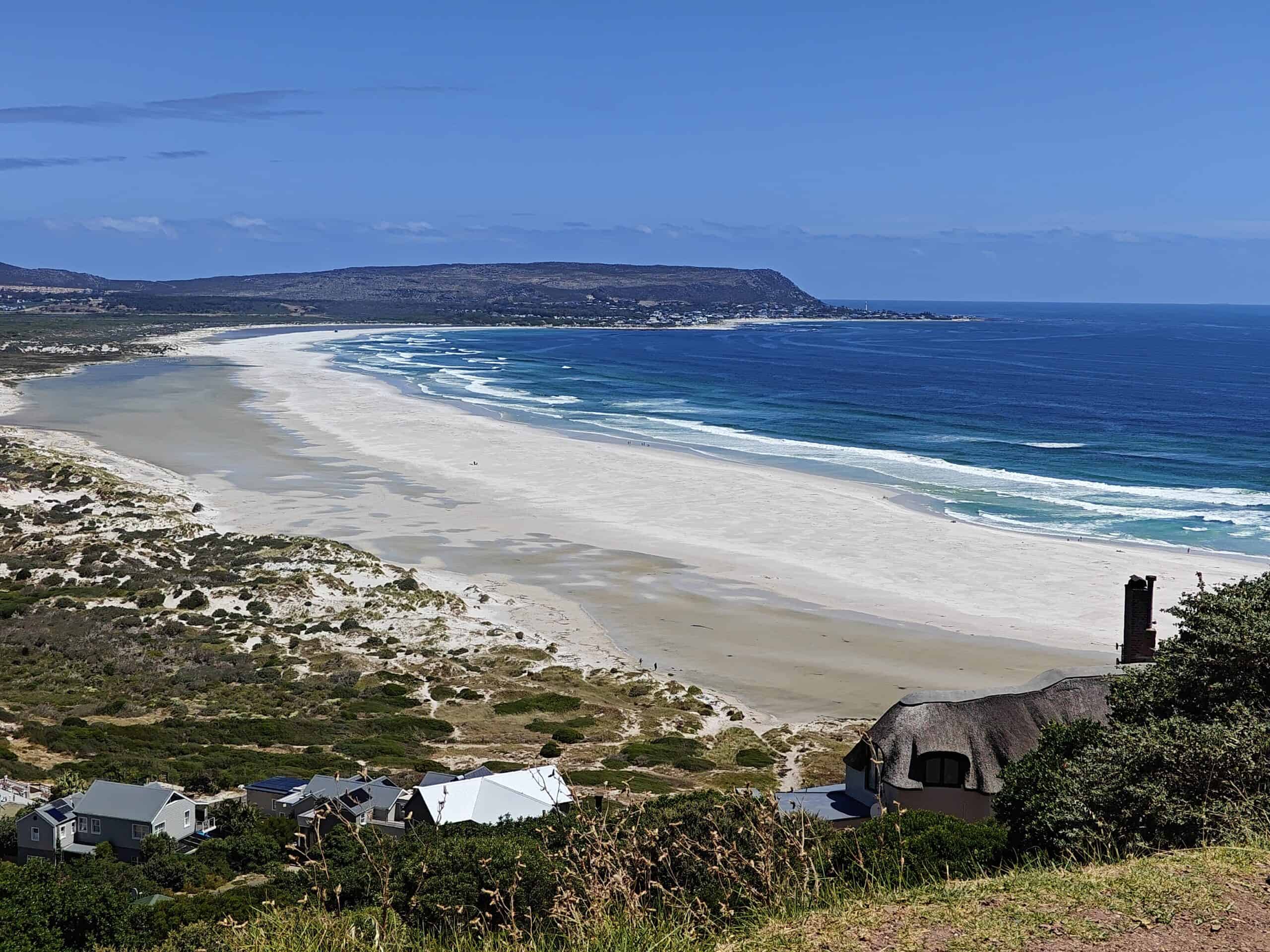

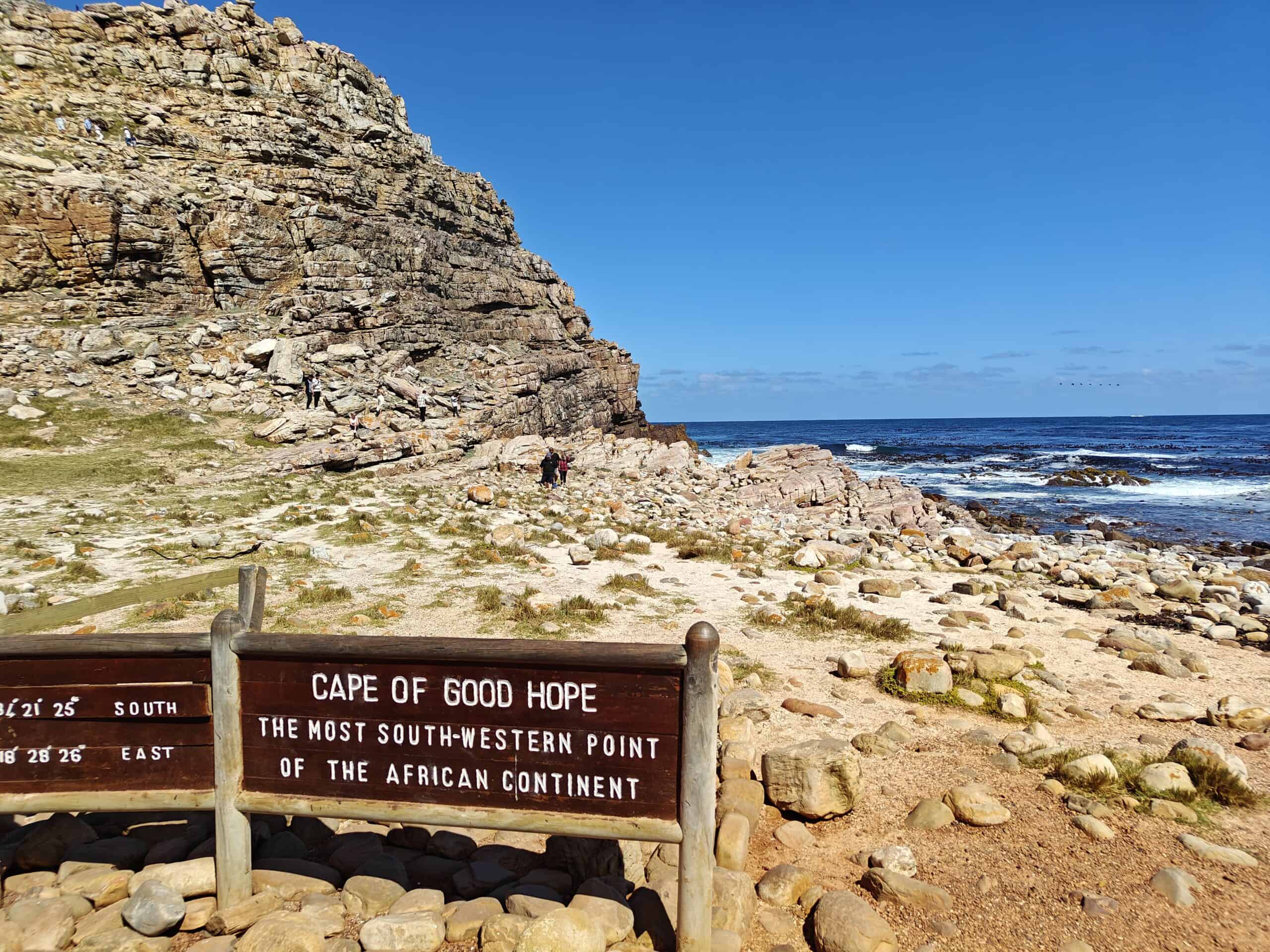
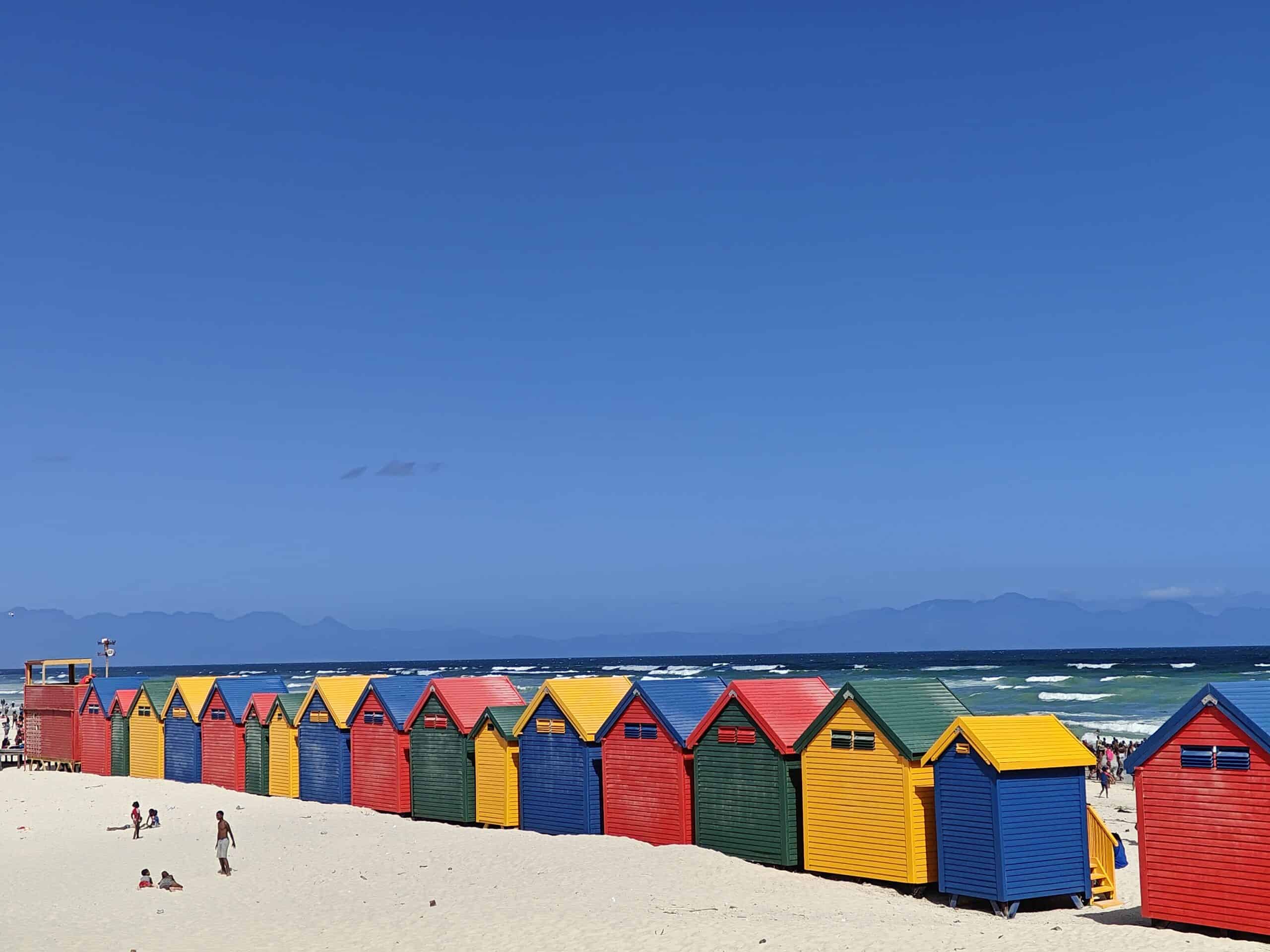
At Cape Point, hike to the lighthouse, breathe in the salty air and spot ostriches casually wandering nearby. The rugged cliffs plunging into the sea below might just give you goosebumps.
Boulders Beach & Simon’s Town
We’ve got two words for you: penguin paradise. Boulders Beach is home to hundreds of adorable African penguins waddling freely, totally unbothered by the crowd of smiling admirers. They are fairly small, so don’t expect Emperor Penguins here. But you can swim near them if you’re brave (the water is icy but refreshing). There is no way we’ll let you miss penguins when creating your 10 day South Africa itinerary.
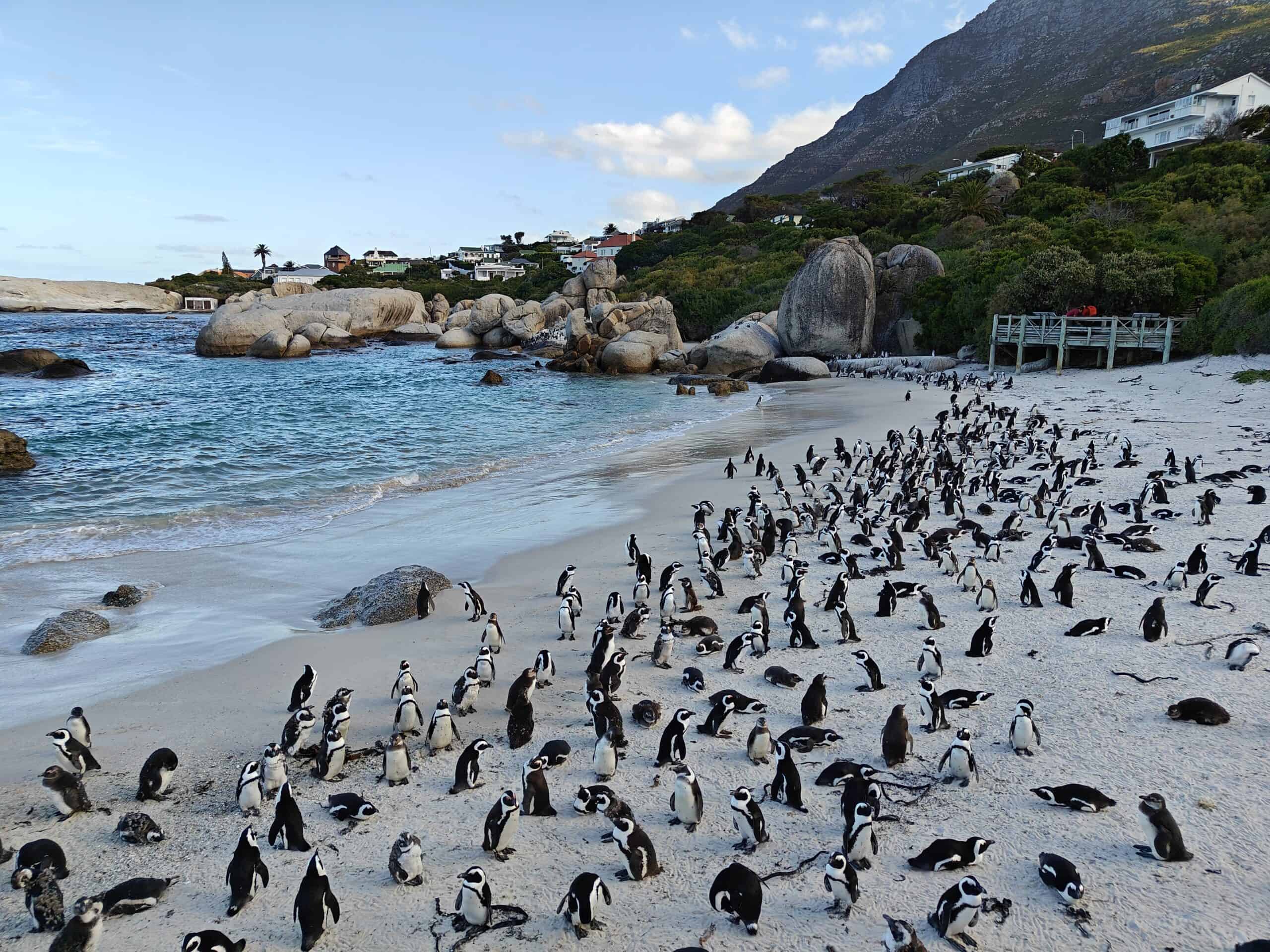

Simon’s Town itself is charming, with quaint cafés and old-world shops lining the main road. Perfect for a leisurely afternoon stroll and a seafood lunch at Bertha’s or Seaforth Restaurant.
Table Mountain
Table Mountain isn’t optional, it’s essential. If you’re feeling energetic, tackle the Platteklip Gorge hike. It’s steep but rewarding, taking about 2-3 hours. If you’re more in chill-mode, the cableway provides panoramic views without the sweat. At the summit, trails snake across the flat-topped mountain, offering endless photo ops. We’ve been up numerous times and still feel awed each visit.
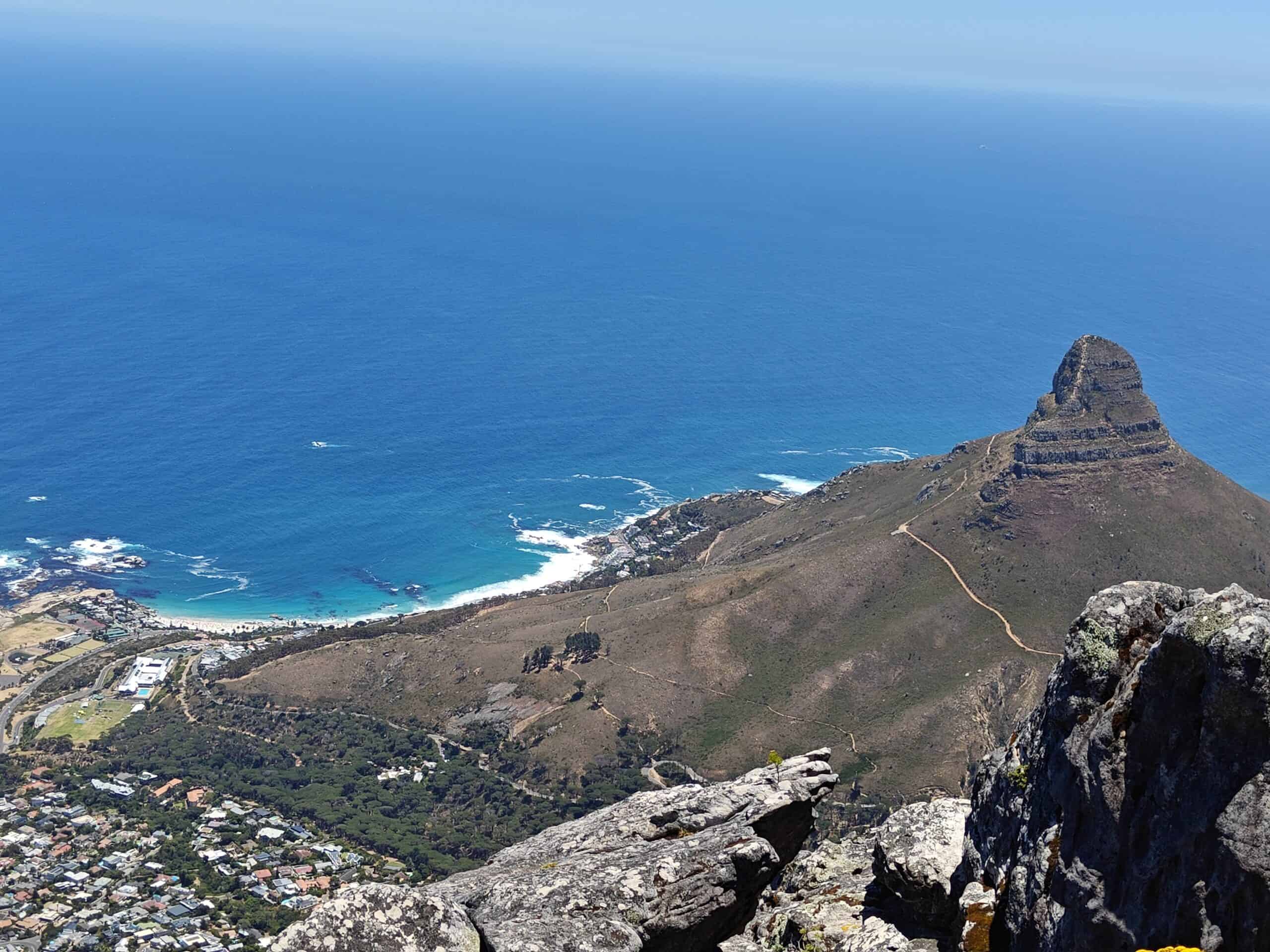
(Don’t forget to read our safety tips at the end of the post)
Food Scene & Must-Eats
Cape Town’s culinary scene effortlessly blends local flavors, international trends and genuine creativity. Eating here is an adventure and these are the dishes we’ve found most memorable:
- Bunny Chow: Originally Durban-based, bunny chow is a spicy curry served inside a hollowed-out bread loaf. Our favorite spot is Eastern Food Bazaar which is cheap, delicious and authentically messy.
- Bobotie: A mildly spicy minced meat dish topped with an egg-based custard. Gold Restaurant offers an amazing African-themed feast with bobotie as one of the highlights. It’s theatrical dining at its best.
- Gatsby Sandwich: Imagine a sub sandwich, but on steroids. Packed with fries, meat, sauces and veggies. This is Cape Town street food royalty. Head to Super Fisheries in Athlone, they’ve perfected the Gatsby art.
- Braai: South Africans are passionate about braai (barbecue), and the city offers endless venues to indulge. Mzoli’s Place in Gugulethu provides a lively township vibe, smoky meats and music-filled afternoons. It’s an experience as much as a meal.
Other foodie must-visits:
- The Pot Luck Club: Trendy tapas-style dishes served atop the Old Biscuit Mill. Each dish is a work of art, full of bold flavors and creative twists. Reservations needed weeks in advance, but trust us, it’s worth planning ahead.
- Oranjezicht City Farm Market: Weekend market, perfect for fresh juices, gourmet snacks, and vibrant local produce. Grab brunch here as it’s fresh, seasonal and utterly delicious.
- Truth Coffee: This steampunk-themed café isn’t just for aesthetics. The coffee is genuinely superb and breakfasts here kickstart your day in style.
These four days in and around Cape Town offer a perfect balance: culture, adventure, relaxation and delicious indulgence. By now, you’ll understand exactly why it’s so hard for anyone (us included!) to say goodbye to this city.

Days 5–7: Kruger National Park & Panorama Route Experience
Getting to Kruger from Cape Town
Cape Town and Kruger feel worlds apart: one all bustling streets and coastal charm, the other raw wilderness. The diversity itself makes it worthy of including Kruger in any 10 day South Africa itinerary. Bridging this gap is easy if you fly. Grab a direct flight from Cape Town to either Hoedspruit (Eastgate Airport) or Nelspruit (Kruger Mpumalanga International Airport). Flights are under three hours, so you can leave behind city vibes by breakfast and be on safari by afternoon.
We prefer Hoedspruit, it’s closer to Timbavati Game Reserve, about 45 minutes by car. Nelspruit works too, especially if your itinerary includes the Panorama Route, as it’s perfectly situated nearby. Car rentals and transfers are easy from either airport. Book early, particularly in peak safari season.
Driving from Cape Town is theoretically possible but brutal (about 20 hours). Save that adventure for another trip when time isn’t tight.
Timbavati Game Reserve
Timbavati offers exactly what you picture when dreaming of an African safari – wildlife encounters minus crowds. We love it for this exact reason. Game drives here feel intimate and unrushed, sightings are truly spectacular.
On our last visit, we tracked a pride of lions lounging lazily by a waterhole after a kill and spent quiet moments observing elephants in dense woodland. The excitement in your guide’s hushed voice when spotting rare wild dogs or a leopard strolling by is unforgettable.
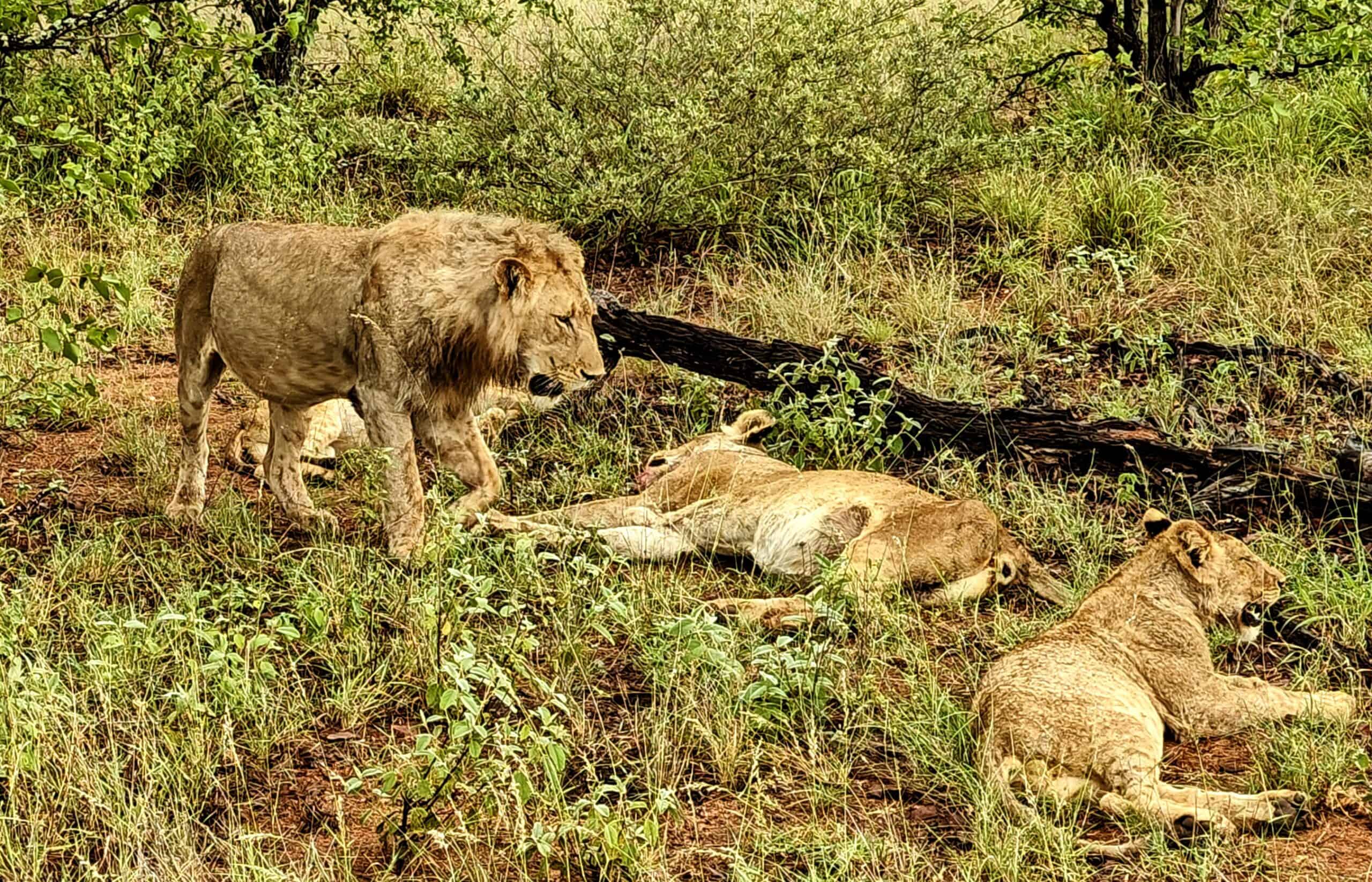
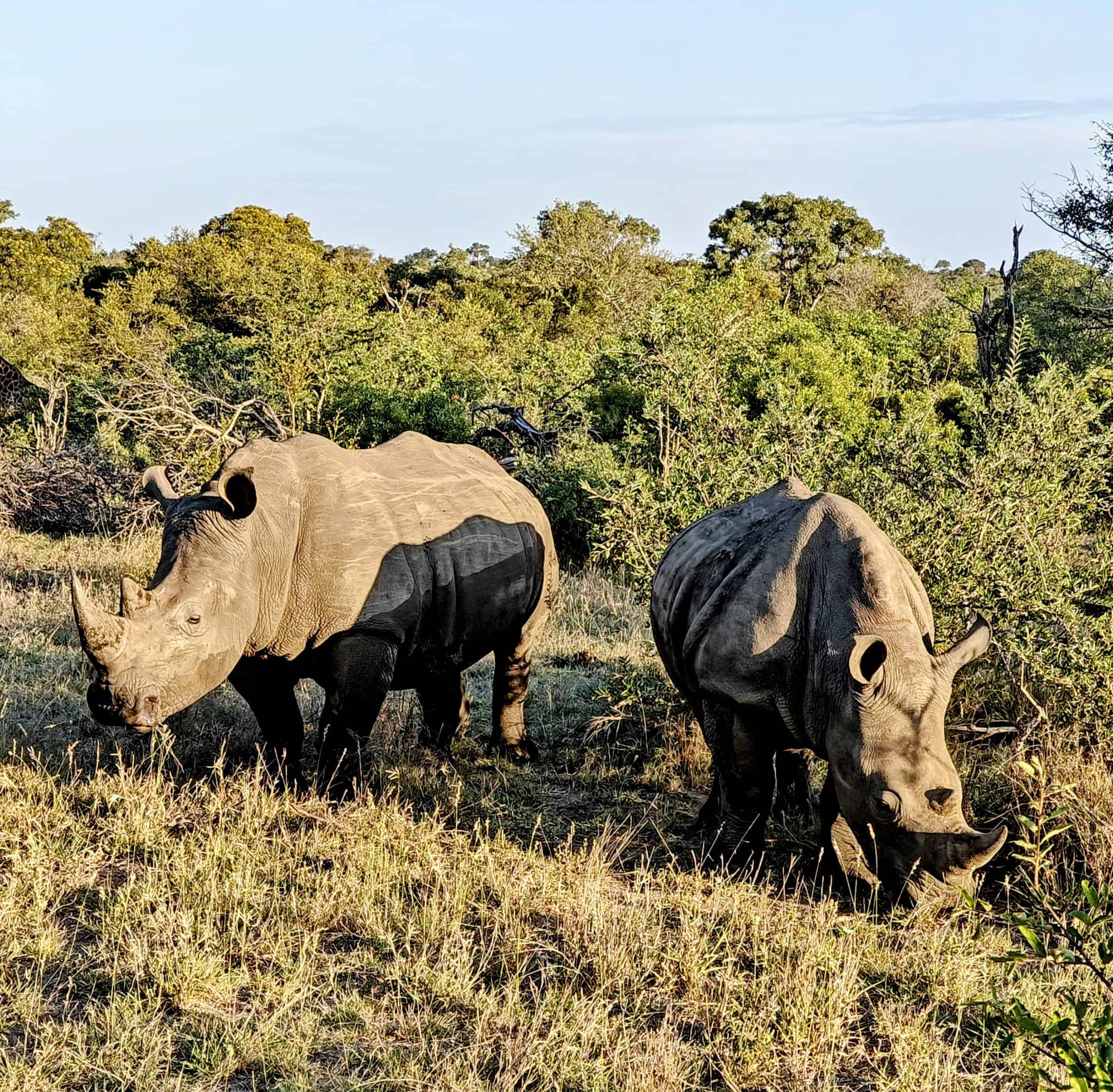
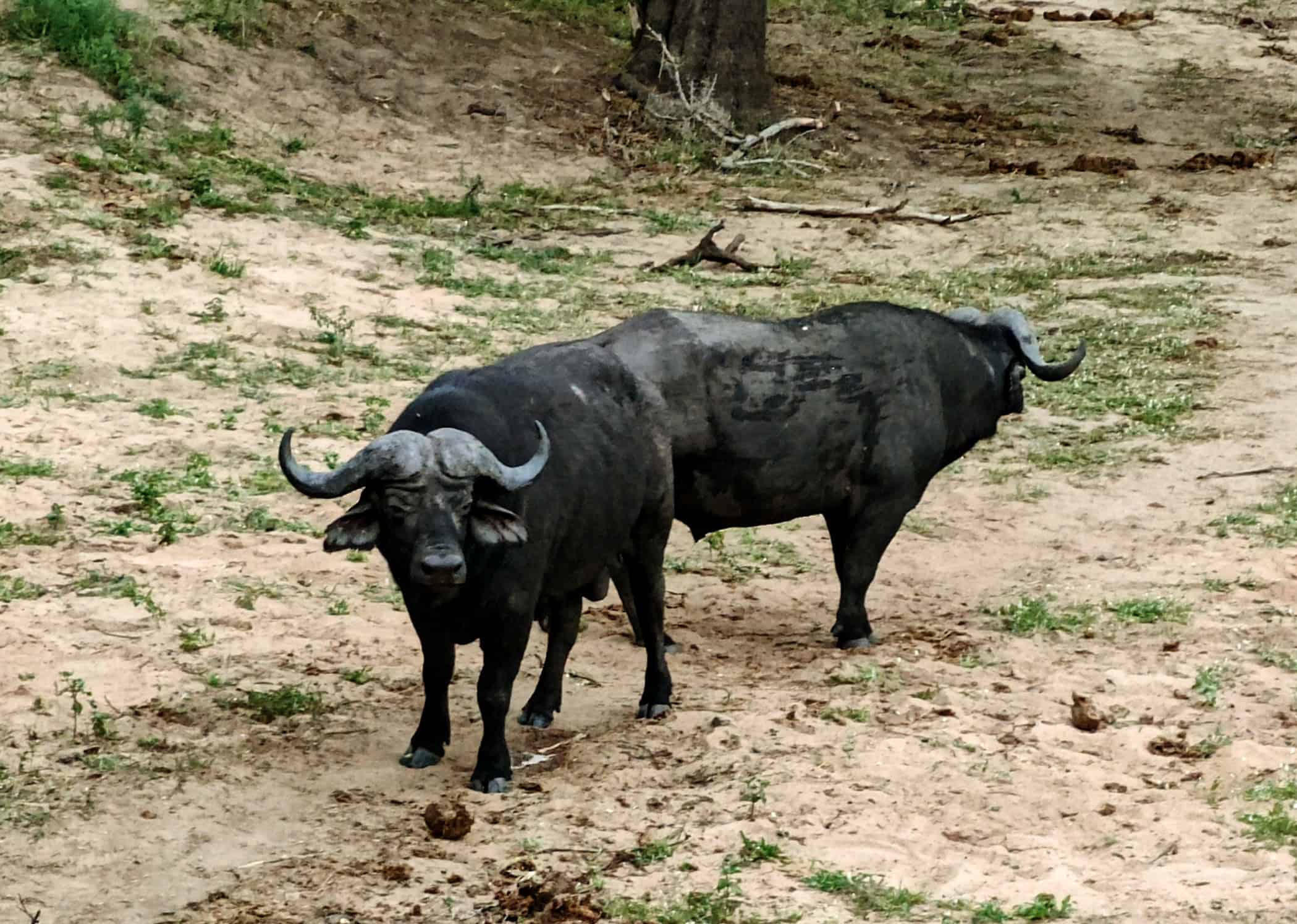
Lodges like Motswari (we stayed here and highly recommend) or Simbavati give you the perfect blend of rustic luxury and authentic bush experiences. Days start early with sunrise game drives. Nothing beats sipping coffee while watching animals stir in the golden morning light. Afternoons offer downtime before another drive at dusk. And yes, sundowners! Sipping a cold drink as the sky blazes orange is a daily highlight.
At night, we loved falling asleep to the symphony of wildlife, with distant lion roars echoing through the bush. Timbavati is magical and wild, precisely how safari should feel.
Off-the-Grid Adventure at Manyeleti Camp
For something completely different, we also spent a night at Manyeleti Camp. It’s rustic, simple and blissfully unplugged. No Wi-Fi, limited electricity. Just lantern-lit tents and nature’s soundtrack.
We were initially skeptical! Can we handle this much isolation? But honestly, it quickly became a highlight. Afternoon bush walks gave us an intimate understanding of nature: footprints, bird calls, the fascinating skill of tracking animals on foot.
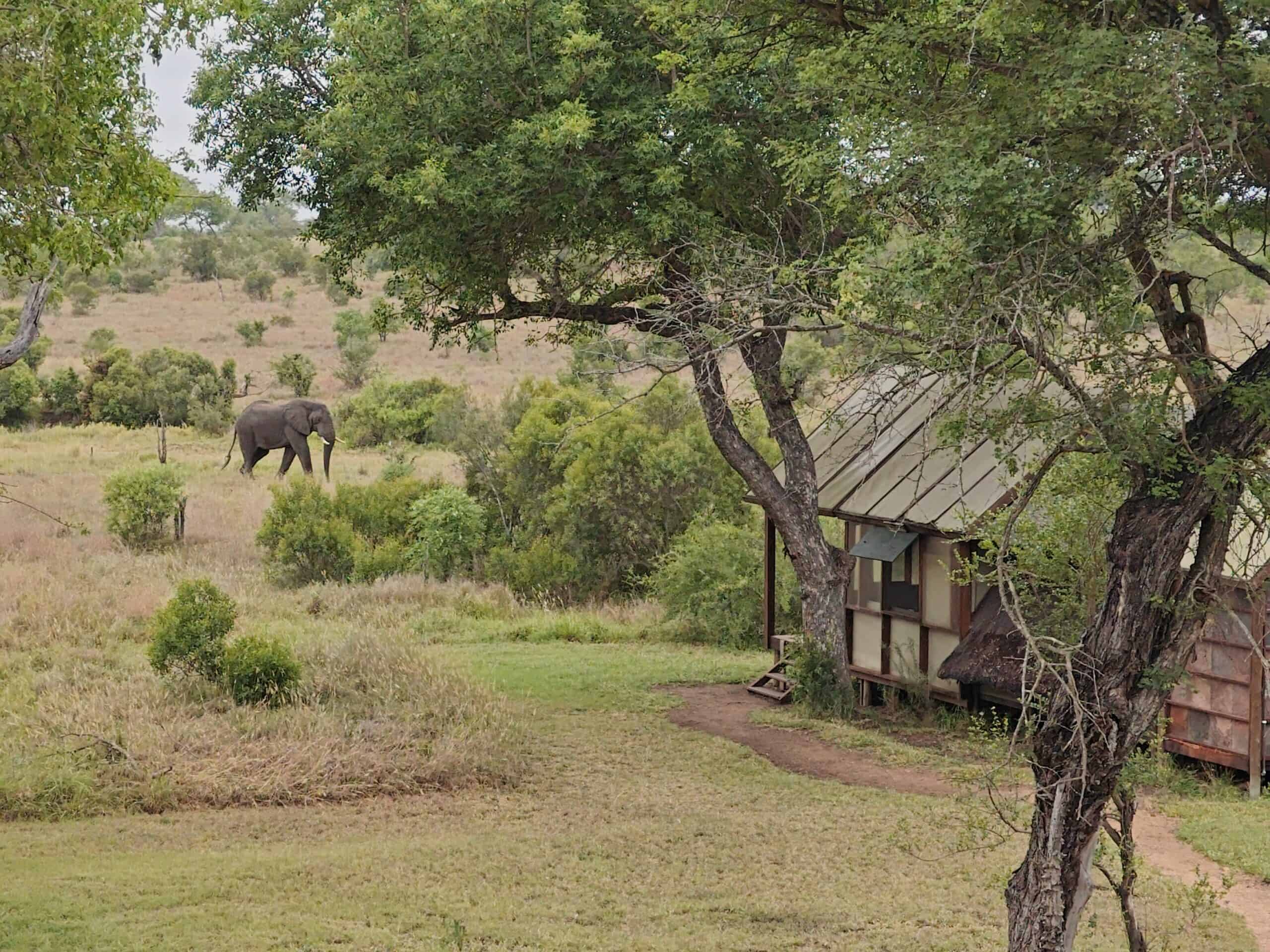

Nighttime was enchanting. Gathered around a crackling fire, swapping safari tales under stars brighter than we’ve seen anywhere else, it felt timeless. Sleeping was, umm, interesting. Crazy thunderstorms and sounds of distant lions and close-by hyenas. Manyeleti is raw, authentic Africa. If you’re looking to reset and reconnect, spend at least one night here.
Exploring the Panorama Route
Since you’re already near Kruger, it’d be a shame to skip the Panorama Route. This is a drive that’s less about wildlife and more about jaw-dropping scenery. We set aside half a day here, and honestly, it became one of our best decisions.
Begin in Graskop, grabbing pancakes at the famous Harrie’s Pancakes (trust us, worth every calorie). Next, explore viewpoints like God’s Window, where lush forests spill dramatically into valleys below. Mist hangs over the cliffs, creating an almost mystical feel which is perfect for memorable photos.
Next, Bourke’s Luck Potholes offer surreal geological formations sculpted by swirling waters over centuries. The walkways make exploring easy, offering numerous angles to capture these natural wonders.
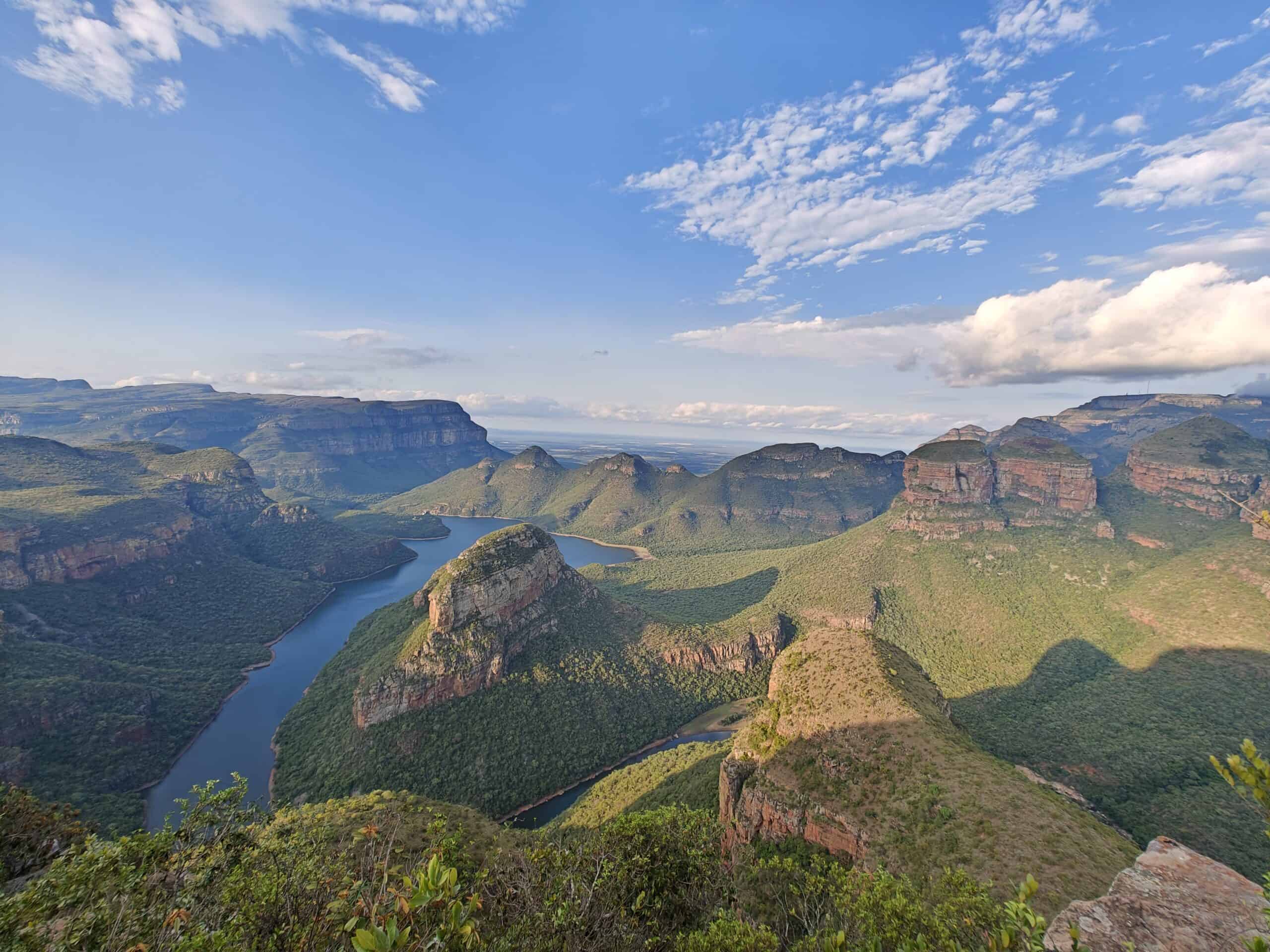
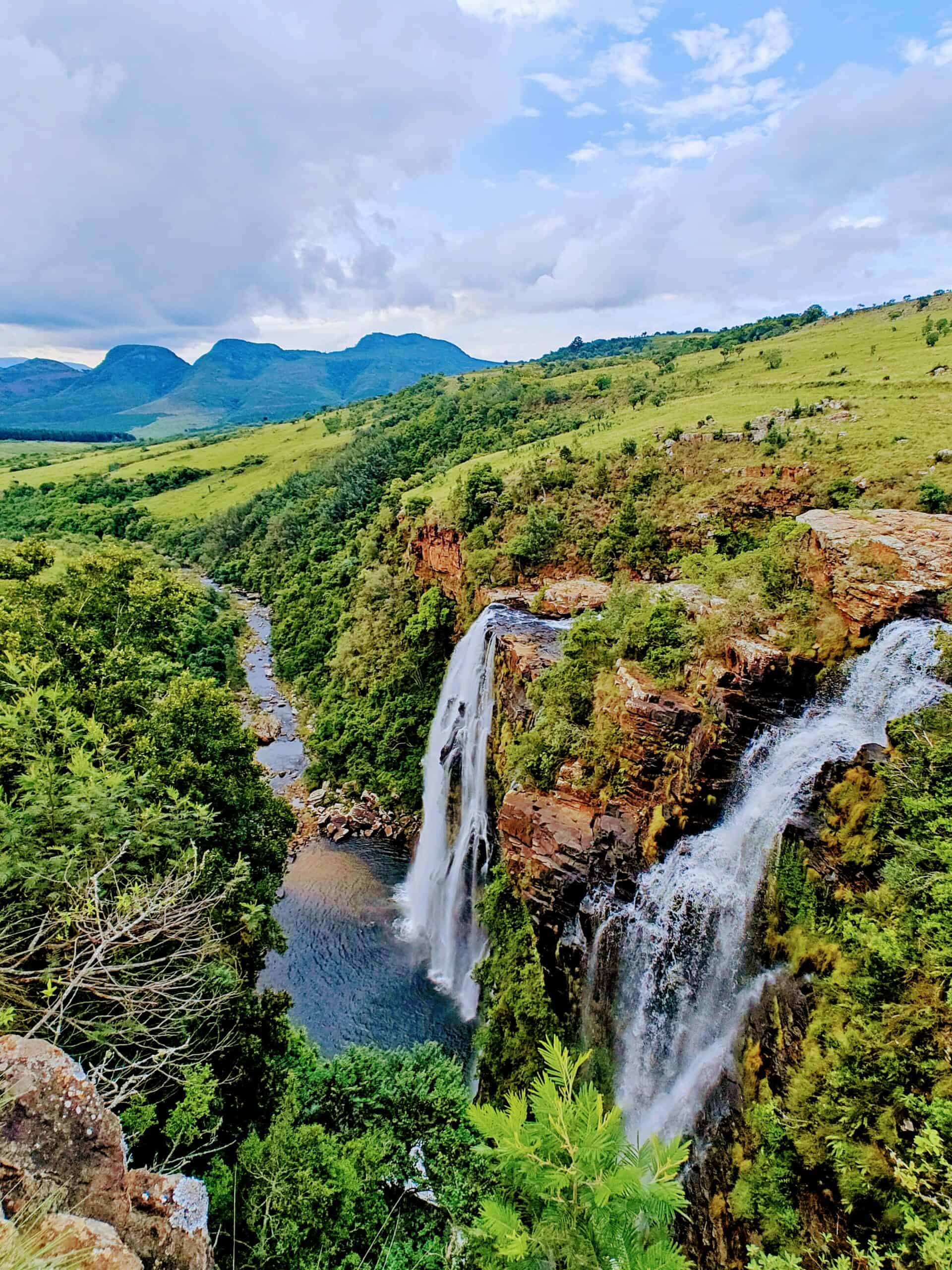
Our favorite spot was Blyde River Canyon: the third-largest canyon globally and arguably the most photogenic. The view from Three Rondavels viewpoint, resembling traditional African huts, is spectacular, especially at sunset. We met an older Dutch couple who’d been RV-ing across Southern Africa for the past few months, and their stories were just awesome.
If you’ve got more time, Lisbon and Berlin Falls are also worth quick stops, each offering impressive cascades plunging dramatically into lush surroundings.
The Panorama Route is accessible from Timbavati or Manyeleti. Just plan to start early, giving yourself ample daylight hours to truly soak it in.
Food Experiences in Kruger
Meals in Kruger might lack Cape Town’s culinary sophistication, but they offer unforgettable charm and warmth. Breakfasts are hearty, lunches relaxed and dinners communal, typically beneath vast African skies.
Expect dishes like grilled meats (braai, again!) served alongside maize porridge (pap) and spicy chakalaka relish. My favorite safari dessert? Malva pudding – sweet, comforting perfection.
The communal dining aspect is special. Conversations flow naturally, as fellow travelers share stories of sightings and safari highlights. It’s not just dining, it’s bonding.
Days 8–10: Garden Route Road Trip
Getting from Kruger Area to the Garden Route

Leaving Kruger’s wild savannah behind and heading to the Garden Route feels like switching channels from a gripping documentary to a gentle travel show. Equally captivating, just completely different. It’s an easy transition, especially if you plan ahead.
The best way to navigate this stretch is to fly from Hoedspruit or Nelspruit via Johannesburg to George Airport which is the gateway to the Garden Route. Flights are frequent, with total travel time around four hours including the layover. We’ve found it’s best to schedule a morning flight, giving you plenty of daylight hours once you land.
At George, renting a car is straightforward and crucial. You’ll want wheels to properly explore the scenic coastal stretch ahead. We recommend booking ahead, especially during high season when demand spikes.
From George, it’s a short, picturesque 45-minute drive eastward to Knysna, your base for exploring the Garden Route (and our favorite place on the Garden Route, where we celebrated Isheeta’s birthday!) The winding roads, lush forests, and ocean views ease you gently into this new leg of your adventure. Roll down your windows, let that salty sea breeze hit you, and welcome to one of South Africa’s most beloved coastal escapes.
Garden Route Highlights
Knysna
Knysna isn’t just beautiful, it’s postcard-perfect, almost unfairly charming. Nestled on a sparkling lagoon, framed by dramatic sandstone cliffs called “The Heads,” this town radiates relaxed coastal energy. Think sailboats bobbing lazily, art galleries, cozy cafes and seafood restaurants lining the waterfront.
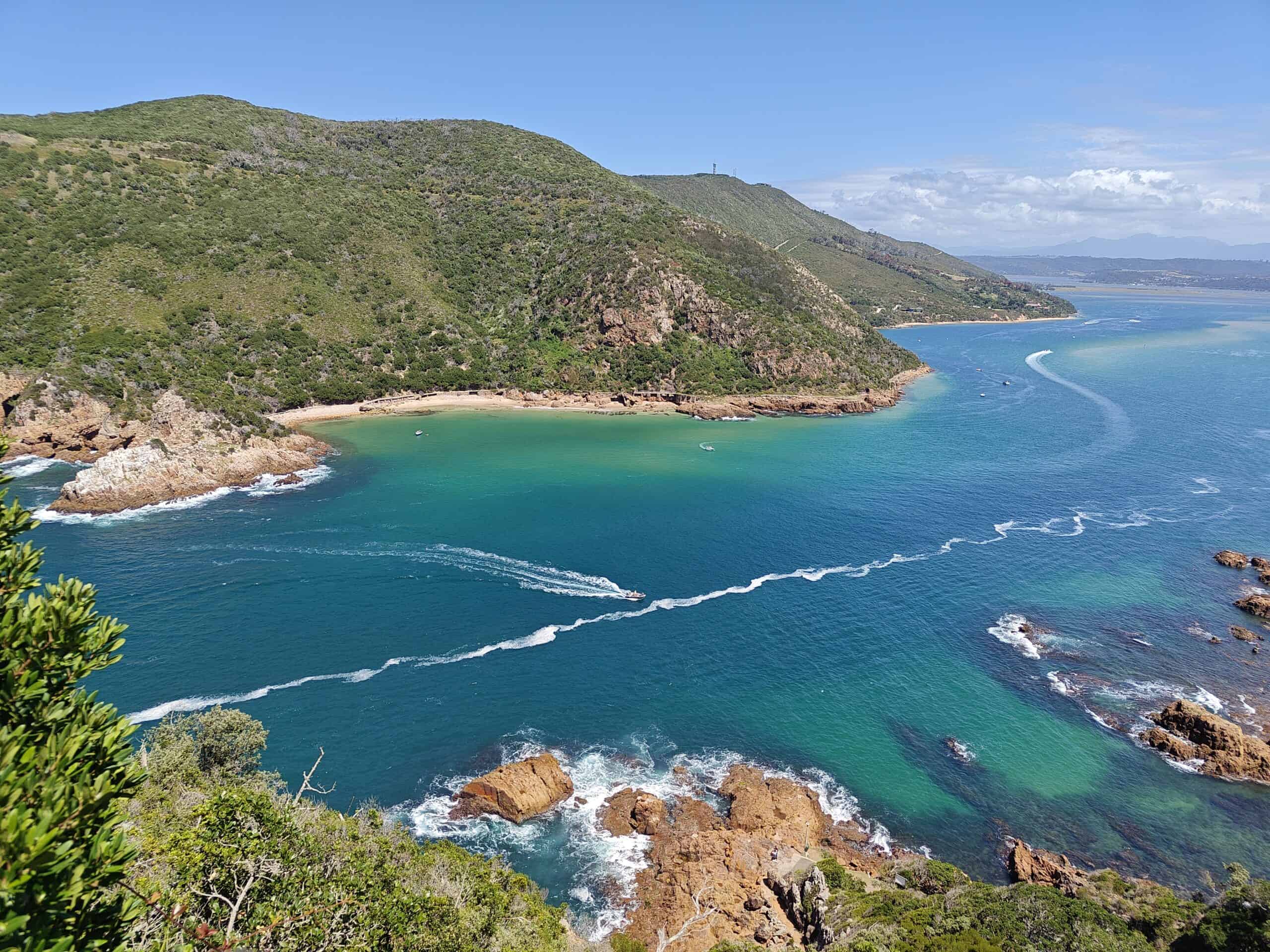
On your first evening, stroll the Waterfront, a lively area buzzing with boutiques and eateries. The fresh oysters here are famous for good reason. Our favorite spots? 34 South for oysters paired perfectly with crisp local wine, or Freshline Fisheries for laid-back, toes-in-the-sand seafood dinners. Trust us, these oysters taste like the sea captured in a single bite. Go to Nest Food Bar for a perfect sunset with a drink in your hand.
During the day, hop on a lagoon cruise. Utterly lovely and dolphins sometimes join alongside the boats, a magical bonus. Or drive up to the East Head viewpoint. It’s spectacularly panoramic, making you want to linger forever. We’ve returned here several times just to soak in the views.
Knysna is the kind of place you’ll miss before you’ve even left. And such a place has to be included on a 10 day South Africa itinerary. Its combination of natural beauty, easy-going charm and seriously good food makes it the perfect Garden Route base.
Tsitsikamma National Park
Heading east from Knysna, within an hour you’ll hit Tsitsikamma National Park, one of the most pristine, lush stretches of the Garden Route. This is nature at its most cinematic, all dense indigenous forests, thundering waves, and rugged cliffs.
A must-do is the hike to the Storms River suspension bridge. The path meanders through dense greenery, crossing rivers and streams until you reach the gently swaying bridge. Crossing it feels like stepping into another world. If you’re up for more adventure, kayaking or tubing down Storms River is exhilarating. A bit chilly, yes, but completely invigorating.
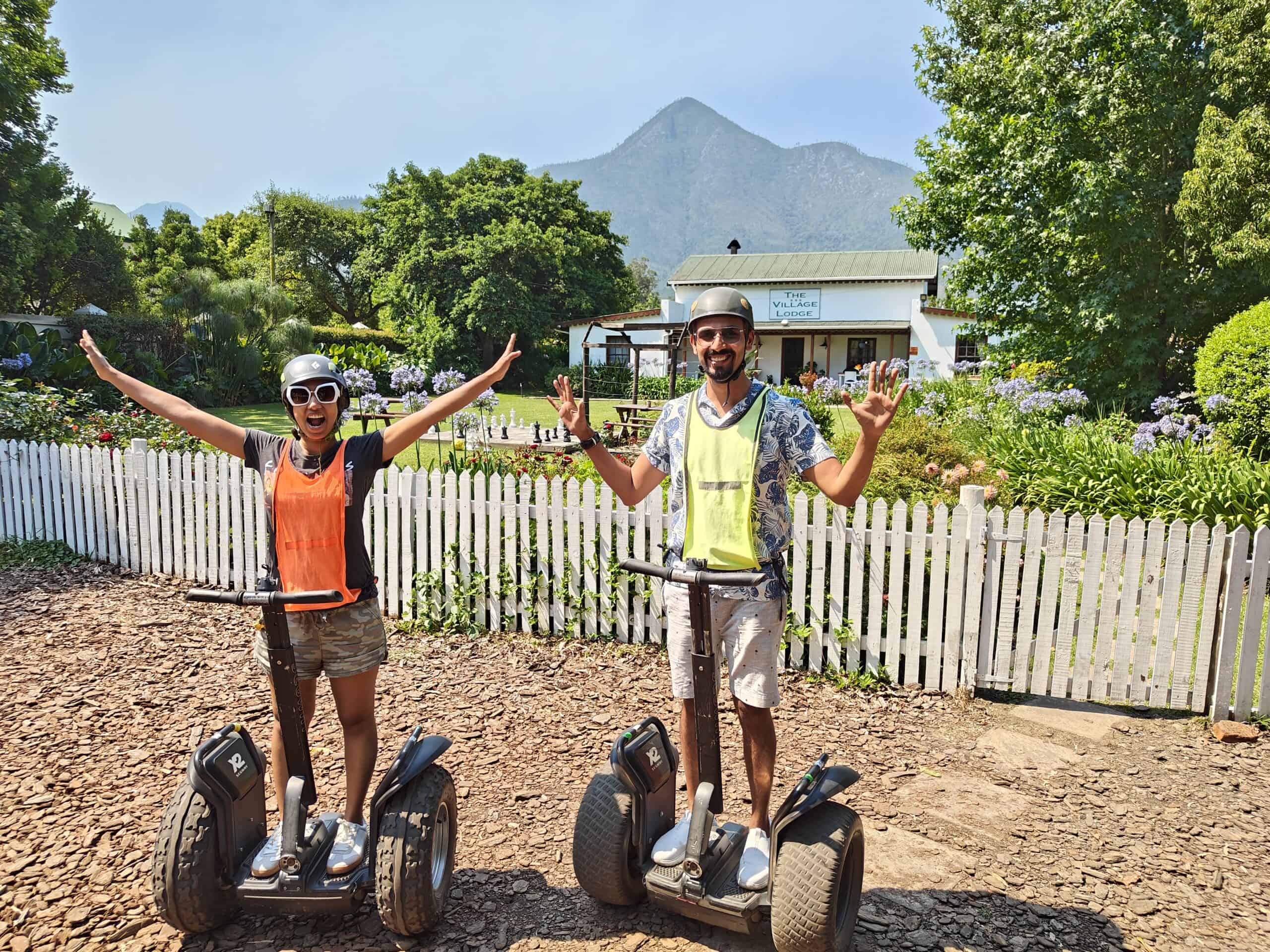
Another favorite we were told of is the easy hike to the Waterfall Trail, where you’ll pass secluded beaches and rocky shores before reaching a picturesque waterfall cascading into the ocean. It’s the kind of spot where you linger a little longer, dipping your toes and just breathing in the freshness.
Tsitsikamma is South Africa’s outdoor playground. Pristine and energizing, yet peaceful enough to recharge your batteries after busy days of travel.
Plettenberg Bay & Robberg Nature Reserve
Just a short drive west of Tsitsikamma lies Plettenberg Bay (“Plett” to locals), a seaside town that effortlessly combines upscale vibes with laid-back beach town charm. You’ll find golden beaches stretching endlessly, perfect for swimming, surfing or simply lounging with a good book.
But the star of Plett, in our opinion, is Robberg Nature Reserve. It’s ruggedly beautiful, offering trails that snake around the peninsula. Expect jaw-dropping ocean views at every turn, plus a good chance of spotting dolphins, whales and even seals basking lazily on the rocks below. The full loop hike takes about three hours, but shorter trails offer equally stunning scenery. Pack snacks, plenty of water and a camera. You’ll thank us later.
In town, there are plenty of cozy cafés and shops worth exploring. Grab lunch at The Fat Fish, super fresh seafood, creative cocktails and views of the bay that make lingering easy. It’s the kind of place you daydream about returning to.

Food Scene along the Garden Route
Eating your way along the Garden Route is half the joy of the journey. Here, dining isn’t just about sustenance. It’s about slow, relaxed indulgence. Fresh seafood, local produce, and artisanal creations dominate menus.
- Oysters in Knysna: Don’t leave without savoring freshly shucked oysters. 34 South does them raw, grilled, fried, you name it. Or hit Freshline Fisheries for simple, casual dining. Pair with a crisp Sauvignon Blanc from nearby wine regions, and you’ll truly understand local pride in these oysters.
- Wild Oats Community Farmers Market (Sedgefield): Open Saturdays, this vibrant market is brimming with fresh-baked breads, local cheeses, handmade chocolates, and organic veggies. We always stock up here. It’s impossible to resist nibbling as you wander through the stalls.
- Local Craft Beers: South Africa’s craft beer scene has exploded, and the Garden Route is right in the mix. Mitchell’s Brewery in Knysna is a long-standing favorite (try their Old Wobbly Lager. Great name, great beer), and the vibe here is as good as the drinks.
- Farm-to-Table Restaurants: Stop by Zinzi near Plettenberg Bay for an elegant yet unpretentious meal. Surrounded by forest, dishes like lamb shanks and fresh fish are memorable, comforting, and delicious.
- Beachside Dining: The Lookout Deck in Plettenberg Bay offers casual seafood dining and sunset views, perfect for lazy afternoons. Order fish tacos, calamari, or a simple burger and wash it down with something cold. Pure seaside bliss.
Wrapping Up & Return to Cape Town
As you loop back towards Cape Town, consider taking the inland R62 route through the Klein Karoo, a contrasting landscape of mountains, vineyards, and quaint towns like Oudtshoorn (known for its ostrich farms). This scenic drive adds another dimension to your journey home, subtly shifting from coastal beauty to rugged interior charm.
Your final stretch into Cape Town gives you time to reflect. The past ten days have been a whirlwind – Cape Town’s bustling energy, Kruger’s wild magic and the Garden Route’s serene beauty. It’s remarkable how diverse South Africa is, how effortlessly it shifts between urban sophistication, untamed wilderness, and relaxed coastal living.
As we approached Table Mountain once again, we definitely felt a sense of completeness mixed with a twinge of nostalgia. The truth is, even after months of traveling here, we always find leaving South Africa bittersweet. It’s a place that lingers, pulling you back again and again.
This 10 day South Africa itinerary is just the beginning. South Africa is full of endless adventures, each visit revealing something new. But if your time is limited, these ten days are, in our experience, the absolute best way to feel the heartbeat of this incredible country.

Staying Safe in your 10 day South Africa itinerary
Cape Town is stunning, vibrant and endlessly charming, but let’s talk honestly for a second. Like many major cities around the world, Cape Town faces real issues with crime, and some news stories can feel pretty alarming. Having spent months exploring its streets, we understand those concerns firsthand. I was s***-scared the first time we landed in Cape Town.
First things first: awareness is your greatest tool. Most problems travelers encounter are preventable with basic precautions. For starters, avoid walking alone after dark, especially in quieter or less-touristy areas. Stick to busy streets or take registered taxis or Uber, since it’s reliable and affordable here.
Keep valuables discreet. Don’t flash jewelry, expensive cameras or phones openly, especially downtown or in crowded markets. We often used cross-body bags or backpacks zipped tightly and worn on the front in busy areas. Simple but effective.
The city’s popular areas, like the V&A Waterfront, Camps Bay and central neighborhoods, have visible police presence and are typically safe during the day. But after dark, vigilance becomes more important. Areas like Woodstock and Bo-Kaap are vibrant but best visited during daylight unless you’re with a local guide or in a group.
Hiking Safety
For hikes, especially popular routes like Lion’s Head or Table Mountain, always hike with a partner or group, stay on marked paths and avoid early morning or evening treks unless it’s an organized group tour. Incidents are fairly common, and staying cautious goes a long way.
Driving Safety
Cape Town roads are good, but avoid isolated stretches at night. The neighborhoods around the airport are not safe, so do not leave the highway. Park in well-lit, monitored lots, and always double-check your car’s locked. Simple habits that locals follow too.
If you’re feeling uncertain about specific neighborhoods or excursions, talk to your hotel or Airbnb hosts as they offer invaluable local insights about current safety trends.
Cape Town has its challenges, but remember: tens of thousands of travelers visit every year without incident, enjoying everything this incredible city has to offer. With common sense, awareness, and basic precautions, your visit can be safe, relaxed, and memorable, just like ours have always been.
What About Johannesburg, the Winelands, or the Drakensberg?
When planning a trip to South Africa, it’s easy to get overwhelmed. There are so many tempting destinations: lush wine valleys, cosmopolitan cities, mountain escapes. And if you’re anything like us when we first started planning, you’ll probably try to fit in everything. We get it. But after spending months traveling through the country, here’s the truth: less is more in South Africa.
So let’s talk about some of the places people often ask about, and why we’ve left them out of this 10 day South Africa itinerary.
Johannesburg
Joburg has its own energy: gritty, intense, creative and historic. It’s home to powerful sites like the Apartheid Museum and Constitution Hill. We’ve had some fantastic meals in neighborhoods like Maboneng and Melville. But here’s the deal – unless you have extra time or a strong reason to go, it can feel more like a stopover city than a must-see.
It’s also logistically tricky. Flying in and out of Johannesburg just to see a few highlights can eat up precious time. With only 10 days, we’d rather see wildlife in Kruger and explore Cape Town than sit in traffic on the N1.
Stellenbosch and the Winelands

We adore the Cape Winelands. Stellenbosch, Franschhoek and Paarl have world-class wines, charming architecture, and beautiful mountain backdrops. We’ve easily spent full weekends hopping from one vineyard to the next.
But if you’re already squeezing in Cape Town, Kruger and the Garden Route, adding the Winelands means rushing everything or skipping something far more unique, like a game drive or a coastal hike. If you do want wine country, we’d suggest trimming a day off the Garden Route or doing a half-day trip to Constantia, Cape Town’s own wine valley.
Drakensberg Mountains
The Drakensberg is stunning. Towering cliffs, alpine meadows, ancient rock art. It’s ideal for multi-day hikes or wellness retreats. But it’s also pretty remote and not easily accessed from any of the main stops in this itinerary.
To really appreciate Drakensberg, you need time. And if we had 2-3 weeks in South Africa, we’d 100% include it. But with just 10 days? It becomes a detour that throws everything else off balance.
So, Why Stick to Cape Town, Kruger, and the Garden Route?
We designed this itinerary to give you variety without burnout. You’ll experience vibrant city life, epic wildlife, coastal road trips, beach time, and mountains, all in just ten days. It’s not about seeing everything, it’s about doing the best of South Africa well.
And if you fall in love with the country the way we did? You’ll be back. There’s always a next time for Stellenbosch sunsets or Drakensberg peaks.
Promise!
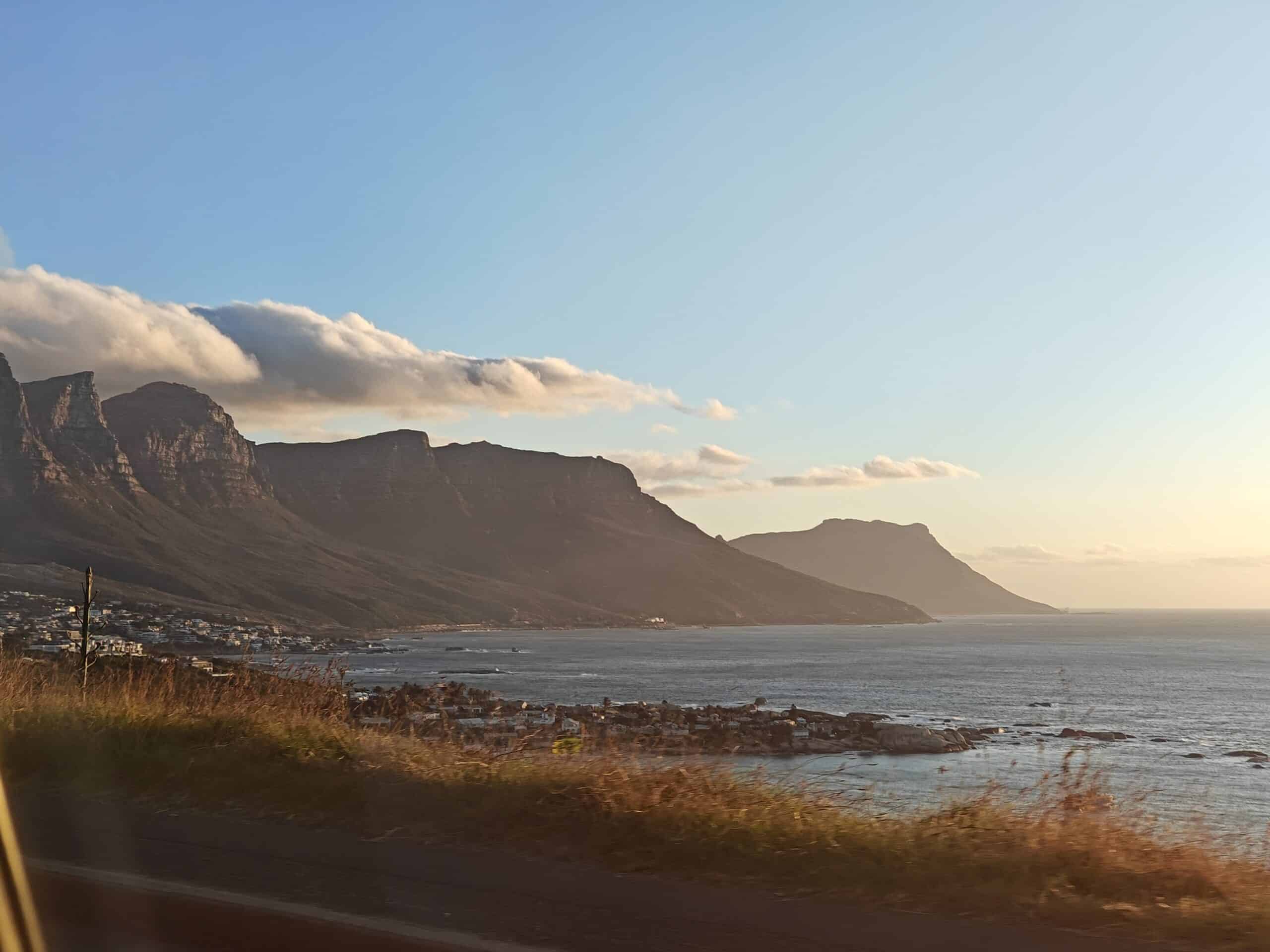
FAQs about the 10 day South Africa Itinerary
Is Cape Town safe in 2025 for tourists?
Cape Town is generally safe for tourists, provided you follow some basic precautions. Stick to busy, well-lit areas at night, avoid displaying valuables openly, and use reputable transport like Uber or registered taxis. We’ve spent extensive time in Cape Town without incident by simply staying aware of our surroundings.
What should I pack for a safari in Kruger National Park?
Packing for Kruger National Park means comfortable, neutral-colored clothing, good walking shoes, sun protection, and a lightweight jacket for chilly mornings. Don’t forget binoculars and a quality camera. Avoid bright colors, as they attract insects and may disturb wildlife and muted tones blend better with nature.
Which neighborhood is best to stay in Cape Town for first-time visitors?
For first-timers, we recommend staying in the V&A Waterfront or City Bowl. These neighborhoods offer easy access to major attractions, plenty of restaurants, shopping, and are well-policed. Camps Bay is ideal if you prefer beach vibes, while Woodstock suits those who love artsy, bohemian atmospheres.
What’s the best month to visit the Garden Route in South Africa?
The best months to visit the Garden Route are typically March-May (autumn) and September-November (spring). The weather is pleasant, crowds are manageable, and prices more reasonable. During these periods, you’ll experience fewer tourists and can fully enjoy spots like Knysna, Tsitsikamma, and Plettenberg Bay.
Where can I see penguins near Cape Town?
The famous penguin colony is at Boulders Beach near Simon’s Town, about a 45-minute drive from central Cape Town. You can walk along boardwalks to watch these charismatic birds or even swim close to them at nearby beaches. Arrive early to avoid the midday rush.
What local food should I eat in Cape Town, and where to find it?
Cape Town’s must-eat dishes include bunny chow (try Eastern Food Bazaar), bobotie (Gold Restaurant), Gatsby sandwich (Super Fisheries), and braai-style grilled meats (Mzoli’s Place). Additionally, fresh oysters at Knysna’s 34 South on the Garden Route are legendary. Food here genuinely makes the trip worthwhile.
Is renting a car in South Africa safe for foreign visitors?
Renting a car is safe and recommended, especially for the Garden Route and day trips from Cape Town. Roads are generally good, signage is clear, and major rental agencies are reliable. Avoid driving long distances at night, stay on main roads, and always lock your vehicle when parked.
Conclusion: 10 Days That’ll Stay With You
If there’s one thing we’ve learned after spending months in South Africa, it’s that this country doesn’t just hand you memories. It etches them into your soul.
In this 10 day South Africa itinerary, you’ll have climbed iconic mountains in Cape Town, shared the road with elephants in Kruger and driven through rainforests that tumble into the sea along the Garden Route. You’ll have tasted food that surprises you, heard languages you’ve never heard before and stared at stars so bright they don’t seem real.
We designed this itinerary for curious travelers with limited time but a deep desire to experience a place properly. You don’t need to rush across every square inch of the map to fall in love with South Africa. These three regions, Cape Town, Kruger and the Garden Route, offer an incredible, diverse, and balanced snapshot of the country at its best.
Yes, South Africa is complex. It’s full of contradictions and layered histories, and you’ll feel that as you move through it. But that’s part of what makes traveling here so rewarding. It humbles you, surprises you and stays with you.
So here’s our advice: Go. Be present. Let the rhythm of each place guide you. And if you find yourself already planning your return by day five, don’t worry, you wouldn’t be the first.
We’ll see you back here. ❤️


